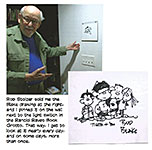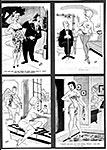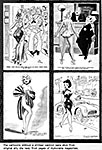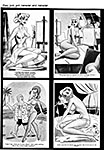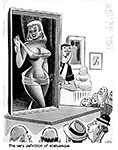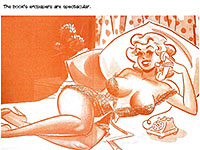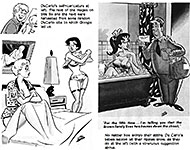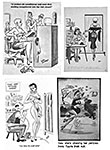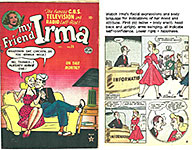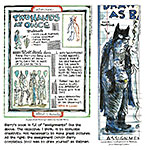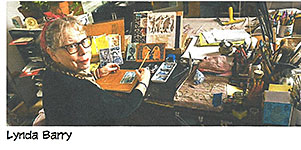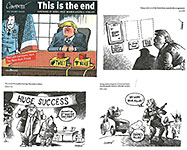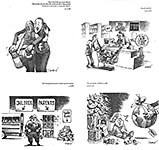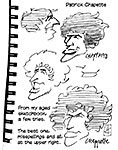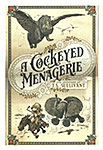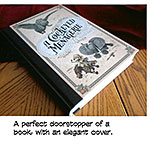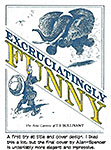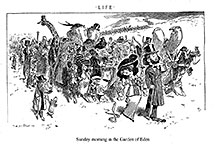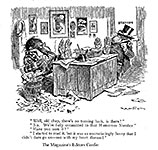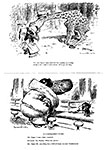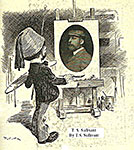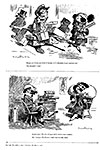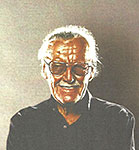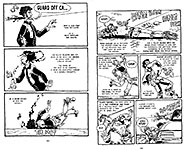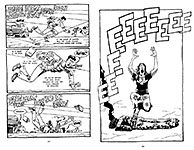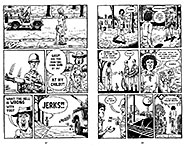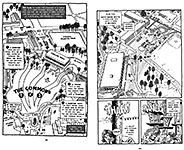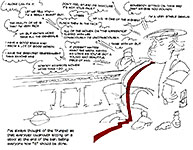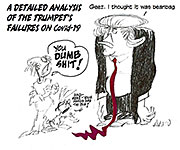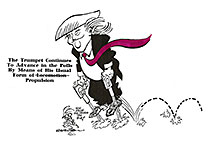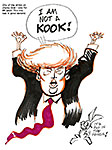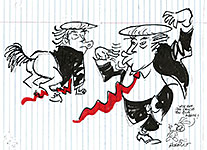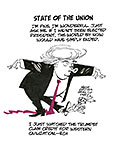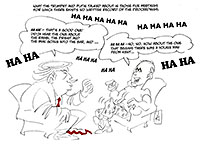 |
|||||||||||||||||||||||||||||||||||||||||||||||||||||||||||
Opus 413 (news thru January 29, 2021). Herein, we admire the work of Dan DeCarlo (particularly cute sexy babes) and T.S. Sullivant (particularly anthropomorphic animals) in new books about them, and we take a long loving look at Bud Blake’s Tiger. We review the Kent State graphic novel and six first issue comicbooks and speculate about DC’s Future State with superheroes’ inner lives; plus news and editoons from the last month and lists of comic strips ending in 2020, comic strips starting, and cartoonists dying. And a list of R.C. Harvey’s 17 books and all of his Trumpet cartoons. And more. So much more that we’re providing a reader’s guide. Here’s what’s here, by department, in order (the longest entries are marked with an asterisk* a reader’s guide to help you decide where to spend your time)—:
NOUS R US Syndicate Pulls Pearls Under the Mask, the Next Batman Will Be Black FCBD Is Back New Yorker On Strike Jack Kirby’s Son Upset by Rioters’ Captain America R.I.P. Julie Strain Satire in Pogo on Display A Riot That Revealed U.S. Hypocrisy Fulcrum Gives Up on Graphic Novels Paper Swears Off Editoons Award Winners Odds & Addenda Roosevelt Hotel Closed COUNTERPOINT Editooning Right and Left
FUNNYBOOK FAN FARE Reviews Of—: Wolverine Black, White & Blood, No.1 Barbalien, No.1 Punchline, No.1 DC Future State Marvel Voices Indigenous Voices, No.1 Wonder Woman, No.1 Kara Zor-el Superwoman, No.1
Stan and Dan and My Friend Irma
TRUMPERIES The Antics and Idiocies of Our Bloviating Buffoon in Chief The Trumpet on the Covers Jim Carrey’s Farewell Portrait of “the Worst First Lady”
EDITOONERY The Mock in Democracy **Selected Editoons from the Past Month
NEWSPAPER COMICS PAGE VIGIL Focus on Tiger by Bud Blake
ACCRETION OF INTENTION DEPARTMENT Review Of—: *Innocence and Seduction: The Art of Dan DeCarlo
BOOK MARQUEE Short Reviews Of—: Making Comics by Lynda Barry This Is the End: The Trump Years by Patrick Chappatte
BOOK REVIEWS Long Reviews Of—: **A Cockeyed Menagerie: The Drawings of T.S. Sullivant *Stan Lee: A Life in Comics
LONG FORM PAGINATED CARTOON STRIPS Reviews Of Graphic Novels *Kent State: Four Dead in Ohio ONWARD, THE SPREADING PUNDITRY The Thing of It Is ... What Did the Trumpet Actually Accomplish? A Personal Note
17 BOOKS BY R.C. HARVEY
Passin’ Through Larry King Comic Strip Departures This Year (2020) Cartoonists Who Died This Year New Comic Strips This Year
QUOTE OF THE MONTH If Not of A Lifetime “Goddamn it, you’ve got to be kind.”—Kurt Vonnegut Our Motto: It takes all kinds. Live and let live. Wear glasses if you need ’em.
But it’s hard to live by this axiom in the Age of Tea Baggers, so we’ve added another motto: Seven days without comics makes one weak. (You can’t have too many mottos.)
And in the same spirit, here’s—: Chatter matters, so let’s keep talking about comics. AND—
“If we can imagine a better world, then we can make a better world.”
And our customary reminder: don’t forget to activate the “Bathroom Button” by clicking on the “print friendly version” so you can print off a copy of just this installment for reading later, at your leisure while enthroned. Without further adieu, then, here we go—:
NOUS R US Some of All the News That Gives Us Fits
SYNDICATE PULLS PEARLS In his Pearls Before Swine comic strip, Stephan Pastis regularly tells jokes that are likely to offend some of his readers. That’s his schtick—seeing whether he can get away with it, this time. But when his distributing syndicate, Andrews McMeel, pulled a week’s worth of the strips scheduled to run in 850 subscribing newspapers in January, that was a surprise. Five of the week’s strips depicted a military coup, and the syndicate felt too many of the Pearls readers would think that sequence was intended to comment on the January 6 insurrection at the U.S. Capitol. But it wasn’t. Like all newspaper comic strips, the Pearls strips are drawn weeks before publication dates in order to gives syndicates time for processing and distribution. These (possibly) offending strips were produced long before the outrageous events of January 6. “The syndicate almost never stops any strips I run, so this is really unusual,” Pastis said in an email interview. “But these are unusual times.” The strips were scheduled to start January 18, reported Dan Taylor at pressdemocrat.com, and run during the week of the U.S. presidential inauguration. On Friday, January 8, two days after the mob riot at the Capitol, the syndicate sent a notice to subscriber newspapers that strips for the week of January 18 would be replaced with substitutes already created by Pastis. The strips haven’t been killed but merely delayed, said Andy Sareyan, the syndicate’s chief executive officer. “We’ll run the strips when things calm down,” Sareyan said. “To run them now just seemed like bad timing. They were about to come out at the time when tensions are running so high in the country.” Pulling the strips for now seems sensible, given our culture's easily offended segments. That they ought not to be offended is another question. Seems that the syndicate, instead of pulling the strips, could have provided a text footnote for all subscribing papers to print along with the strips. Educating the American public is always a noble enterprise— albeit futile.
UNDER THE MASK, THE NEXT BATMAN WILL BE BLACK For months, DC Comics has spread the word that a new Batman will premiere in January. “They also teased that underneath the costume of the new caped crusader would likely be a person of color,” reported George Gene Gustines at nytimes.com. “The identity of the new hero was revealed when DC released a cover of the second issue of the new comic: he is Timothy Fox, one of the sons of Lucius Fox, a business associate of Bruce Wayne, the original Batman.” Timothy Fox will debut as the title hero in “Future State: The Next Batman,” a four-issue series written by John Ridley, the screenwriter of “12 Years a Slave,” with art by Nick Derington, Laura Braga and others. Said Gustines: “The four-issue series will arrive in comic stores in January and February and is part of a two-month event that puts DC’s regular series on hold and replaces them with new ones that look to the future of the DC Universe. “The leap forward has fresh faces taking on the roles of familiar heroes: in addition to Timothy Fox as Batman, Jonathan Kent, the son of the Man of Steel, is Superman, and Yara Flor, who is from Brazil, is Wonder Woman. Some of these future characters are already having ripple effects. The new Wonder Woman, who was created by the writer and artist Joëlle Jones, will be getting a Wonder Girl series set in the present following the event. The character is also being developed as a series for the CW.” In a recent interview, Ridley talked about the target audience for his Batman story: his sons. “They appreciate the things that I do,” he said. “They’re happy for me. They’re great supporters. But they would much rather see ‘Black Panther’ than ‘12 Years a Slave,’ let’s be honest. So to be able to write the next Batman, for them to know that this next Batman is going to be Black, everybody else on the planet can hate it, have a problem with it, denigrate it, but I have my audience and they already love it.”
FCBD IS BACK Free Comic Book Day returns to everyone’s calendar as a single date this year—Saturday, August 14, 2021. FCBD began in 2002 as a marketing stunt designed to draw customers into comicbook shops. It was the result of retailer Joe Field of Flying Colors Comics in Concord, California, brainstorming the idea in the August 2001 issue of Comics & Games Retailer magazine. The day has a three-fold purpose: to thank current comic book readers for their support, to introduce new readers to the joys of comic book reading, and to call back those who may have loved comic books in the past but have been away from them for awhile. Coordinated by the industry's single large distributor, Diamond Comic Distributors, the event has spread to countries in Asia, Europe, and Australia. For the first years, retailers bought regular titles that they then gave away, usually limiting customers to 3-5 comics each. After a year or so, though, comicbook publishers began producing special comics for FCBD—often abbreviated versions of regular titles, sometimes “introductory” issues intended to promote a future title. Again, comicbook shops bought these special editions expressly to give them away. Presumably, the price of these “preview” issues for retailers was much lower than the usual cover price in order to make the exercise financially viable for retailers. For the first several years, FCBD managed to take place on the spring weekend that the year’s first block-buster superhero flick debuted. Gradually, that connection deteriorated to the first Saturday in May. And that’s when it was supposed to occur last year, but the pandemic cancelled the May date. Later, as the terror of Covid-19 subsided somewhat into ordinary fear, FCBD 2020 was reconstituted to spread over several Wednesdays during the final months of the summer. While this maneuver was well-received by fans and retailers around the world, reported Marty Grosser in the Previews catalog, the “big event” feeling was lost. So this year, Diamond and the rest of the retailing industry have revived the one-day tradition. Said Grosser: “We’re all hoping that by August, things will be getting back to normal, and safe for large gatherings of people”—including larger than normal crowds at comicbook shops on FCBD. Here’s hoping.
NEW YORKER ON STRIKE Roughly 100 staffers of The New Yorker magazine walked off their jobs on Thursday, January 21, to protest inequities in pay. Starting at 6 a.m., the walkout included copywriters, web production staff and other union employees; it lasted 24 hours until 6 a.m. Friday. Bylined staff writers were not involved because they are not members of the union. The strike comes after two years of negotiations failed to arrive at salaries both sides deemed fair. The
protest will doubtless interrupt production of the prestigious title (including
its digital platform) helmed by longtime editor-in-chief David Remnick. The
immediate causes of the walkout are the publication of a survey revealing
inequities in the magazine’s pay scales and sharply conflicting salary
proposals. The NewsGuild union released a survey on Wednesday that suggested a wide pay disparity among non-writer editorial staffers at the magazine, particularly women of color. On average, the union claimed, the magazine pays its female staffers $7,000 a year less than their male counterparts. After two years of negotiations, the union said, it proposed a base salary of $65,000 a year with gradual pay hikes so that all editorial workers could survive in New York City, where the magazine is based. The magazine management’s counter-offer was “an offensive and unacceptable response to the Guild’s wage proposal.” The company offered a $45,000 base salary, which the union said is only $3,000 more than the lowest current full-time salaries. Negotiations continue.
JACK KIRBY’S SON UPSET BY RIOTERS’ CAPTAIN AMERICA Mike Lynch, at his Facebook page, reports on January 15 that Jake Tapper (one-time cartoonist; now a CNN commentator) said the following on his Twitter account: "Neal Kirby, the son of Captain America co-creator Jack Kirby, was distressed to see some of the January 6 terrorists/rioters wearing shirts with versions of his dad’s creation corrupted by the image of the outgoing president.” He then provides the following link to Neal’s remarks: https://www.facebook.com/Mike.Lynch.Cartoons/posts/10158065178179397
R.I.P. JULIE STRAIN Heavy Metal model and B-movie actress Julie Strain, a frequent presence at the magazine’s San Diego Comic-Con booth and at other comic conventions, passed away on January 10 after a long battle with dementia, the company announced. She was 58. Strain began appearing in B movies and modeling in the early 1990s, said Milton Griepp at ICv2.com. Her first claim to fame she earned by taking her clothes off: she was Penthouse Pet of the Month in June 1991 (when she was 29) and Pet of the Year in 1993. She appeared in over 100 movies, enough to earn her the title “Queen of the B-movies.” She modeled for numerous artists whose work appeared in Heavy Metal, including Olivia de Berardinis, Simon Bisley, Louis Royo and others.
Strain was married to Heavy Metal publisher Kevin Eastman from 1995 to 2006. I’ve often wondered how that romance got started, Eastman being sort of your average comicbook nebbish and Strain being a statuesque model, 6 feet 1 inch tall (“and worth the climb” as one of the magazines published by Eastman proclaimed). Eastman is co-creator with Peter Laird of the Teenage Mutant Ninja Turtles, an amateur comicbook series that began in 1984. The two creators launched a canny promotion campaign, distributing press kits all across the country. That prompted more issues of the comicbook, plus a tv series in 1987, five live-action films (starting in 1990), and merchandising galore. Eastman started his own publishing firm, Tundra, in 1990, and although it produced many notable products, the enterprise did not take off like the Ninja Turtles did. It never turned a profit, saith St. Wikipedia, and required regular funding from Eastman’s bank account. Then in 1992, Eastman heard Heavy Metal magazine was looking for a buyer, so he bought it. Publisher of a major sf and fantasy magazine. Now that could attract the attention of a 6-foot model. And it apparently did. Here’s how Strain describes their meeting and subsequent marriage: “I
met my husband, co-creator of the Teenage Mutant Ninja Turtles, at the Golden
Apple Comic Book Store in Hollywood. He stood in line to meet me and joined my
fan club. He bought a Polaroid picture with me and a photograph that he still
keeps on his desk; the inscription reads, ‘Kevin you make me smile. Julie
Strain.’ I’ve been smiling ever since. “Being married to him is the greatest joy. He is my soul mate. We wed on Martha’s Vineyard, barefoot on a beach at sunset.” These remarks are quoted from a book of her photographs published by her husband’s company: Julie Strain’s Greatest Hits, published in 2001, midway through their marriage. On the title page, the last word is overprinted by another, “Tits.” From that you can tell she has a sense of humor, which is also revealed in many of her facial expressions in otherwise seductive poses. That may explain a lot. At one time, the Eastmans had homes in Los Angeles, Massachusetts, and Arizona and worked on “a million projects” together. They have a son, Shane, born in 2006, the same year they divorced. Strain’s dementia was believed to be connected to a horseback riding injury she suffered in her 20s. She had been in hospice care since at least 2018.
SATIRE IN POGO ON DISPLAY The political and social satire in Walt Kelly’s comic strip Pogo will be showcased from January 30 through October 31, 2021 in an exhibition curated at the Billy Ireland Cartoon Library & Museum at Ohio State University in Columbus, Ohio. Admission is free. A press release from the Ireland describes the exhibit: “Kelly tackled many of the political issues of the world in which he lived, from the Red Scare to civil rights, the environment, scientific exploration and consumerism. We celebrate Walt Kelly and his social commentary through the joyous, poignant and occasionally profound insights and beauty of the alternative universe that is Pogo. Working in the mid-twentieth century, Kelly drew on the legacy of earlier generations of newspaper cartoonists and then became a major influence on his successors.” The Museum will be temporarily closed April 19 - June 11. The Ireland Library & Museum houses the world’s largest collection of materials related to cartoons and comics, including original art, books, magazines, journals, comic books, archival materials and newspaper comic strip pages and clippings. BICLM is located in Sullivant Hall at The Ohio State University, 1813 N. High Street, Columbus, OH 43210. Explore the collection online at cartoons.osu.edu.
How they see us: A RIOT THAT REVEALED U.S. HYPOCRISY "The city on the hill has lost its shine," said Konstantin Kosachev at Rossiyskaya Gazeta (Russia). The political system that is supposedly the envy of the world was stripped of "its sacredness" on January 6 when a mob of Trump supporters assaulted the U.S. Capitol, killing a police officer and endangering lawmakers as they certified Joe Biden's election win. American politicians and pundits decried the violent protest as a horror, even though they routinely praise such displays in other countries as valid outpourings of anger against undemocratic regimes. U.S. democracy is forever tainted, said Yevgeny Shestakov, also at the Gazeta. The November election that ostensibly went for Biden was "opaque," because numerous states changed voting rules on a whim. No wonder President Donald Trump's supporters feel cheated. From now on, any party that loses an election will be able to plausibly claim that the "results were rigged." The U.S. has lost its right to criticize other countries that quash riots, said Ai Jun at the Global Times (China). Remember when Hong Kong protesters broke into the city's legislative building in 2019? At the time, House Speaker Nancy Pelosi called the scene "a beautiful sight," while Secretary of State Mike Pompeo said the U.S. stood with the activists and supported their "freedom of expression." Yet when the very same thing occurs in the U.S., they "define it as lawlessness" and call it "unacceptable." Unlike their American counterparts, Hong Kong police never fatally shot a protester. What's particularly shocking, said Jafar Blori at Kayhan (Iran), is that the U.S. is now muzzling both the protesters and the president. Facebook and Twitter, under pressure from Congress, erased Trump from their sites and purged many of his followers. " Yes, you heard right, the biggest pretender to democracy and freedom of expression in the world, the one that censures others for supposedly attacking the free press, "overnight became the biggest censor in the world!" Democracy is "America's most important brand," said Oray Egin at Haberturk (Turkey), and Trump has damaged it, perhaps fatally. ... America is now an object of pity and disdain, and nobody is more delighted than Russian President Vladimir Putin, who has long insisted that the U.S. political system is just as flawed and corrupt as Russia's.
FULCRUM GIVES UP ON GRAPHIC NOVELS Colorado book publisher Fulcrum Publishing will sell its line of graphic novels as well as its gardening, natural history, and travel books—126 titles in all— to rival publisher, Chicago Review Press, a publishing subsidiary of the distributor IPG. The transaction, reports Calvin Reid at publishersweekly.com, includes several yet-to-be-published books. Fulcrum has decided to specialize in books on the American West, the environment, conservation, Native American culture, education, self-help, American history, and civics. Fulcrum told Publisher's Weekly that, after expanding into categories such as the graphic novel and gardening, it wanted to refocus on its original mission. Fulcrum Publishing had added nonfiction graphic novels to its line in the last ten years, focused on history, with a strong emphasis on diversity, and had been publishing at least three nonfiction graphic novels a year, marketed to general readers and to comic shops, libraries, and schools. Graphic novels included Matt Dembecki's Trickster; District Comics: An Unconventional History of Washington, DC; Wild Ocean: Sharks, Whales, Rays, and Other Endangered Sea Creatures, Jason Rodriguez's three-volume anthology Colonial Comics, Joel Christian Gill's multiple-volume Strange Fruit, Robert Smalls, Bessie Stringfield and Tales of the Talented Tenth, as well as Captain Of Friendly Cove.
PAPER SWEARS OFF EDITOONS Alexandria Times of Alexandria, Virginia started the new year on January 7 by announcing that it will drop editorial cartoons from their historic place on the editorial page. The Times has no staff editoonist but subscribes to a syndicate service for editoons, which are, of necessity, on national topics only. Alexandria, with a population of 120,000, is within the metropolitan vicinity of Washington, D.C., but despite its proximity to national government—or perhaps because of it— the Times is both hyper-local and stridently non-partisan, and consequentially the presence of a national-focused cartoon on its editorial page has always been an anomaly. And the Times recognized the strangeness in an editorial announcing the demise of its editorial cartoon: “We have heard from many of you through the years questioning our decision to run cartoons that focus on national issues. Our perhaps old-fashioned belief that an editorial cartoon completes opinion pages is what led us to keep running a nationally syndicated cartoon. The national nastiness of last year was part of the impetus to drop the cartoon now.” Another harbinger of the future for political cartoonists.
AWARD WINNERS This year’s Pulitzer Prize for Editorial Cartooning went to illustrator Barry Blitt for his New Yorker covers. Blitt claims he will not miss Donald Trump as a target. “I will not miss him, certainly not as a cartoonist. I’ve drawn him too many times, and spent too much time wringing obvious jokes out of him. I actually found him sort of amusing before he became president, but he ruined our relationship forever by getting into politics. “Every president is a big, fat target,” Blitt went on. “I don’t think Biden has been ripped into enough, owing to the comparative awfulness of his opponent.” Three finalists for the Pulitzer are Lalo Alcaraz, Matt Bors, and Kevin “Kal” Kalaugher. The Overseas Press Club picked Adam Zyglis for its award on international political cartoons. The award was once called the Thomas Nast Award, but then OPC learned that Nast was against Catholics and had committed other sins of that sort, so, in a fever of self-righteous purging of history, they took his name off the award. The Sigma Delta Chi award this year went to Clay Bennett. The Herblock Prize went to Michael de Adder, finalist Matt Lubchansky. J.D. Crowe won the Robert F. Kennedy Journalism Award for editorial cartoons, and Pat Bagley was named editorial cartoonist of the year by the National Cartoonists Society.
ODDS & ADDENDA The historic Roosevelt Hotel in New York City closed permanently in December after nearly 100 years of operations. Owned by Pakistan International Airlines, the hotel cited the coronavirus pandemic and the ensuing drop in business as the principal reasons it will cease operations. Located at 45 East 45th Street (between Madison Avenue and Vanderbilt Avenue) in Midtown Manhattan, the hotel was named in honor of President Theodore Roosevelt. It opened on September 22, 1924; it closed on December 18, 2020. I didn’t spend a lot of time in the Roosevelt, but I spent enough time in the bar there to necessitate a visit to the men’s restroom, which, I immediately discovered, had the most distinctive urinals I’d ever peed into. The urinals were almost as tall as a man—you had the sensation of walking into a small room—and they were stunning black marble.
Fascinating Footnit. Much of the news retailed in the foregoing segment is culled from articles indexed at https://www.facebook.com/comicsresearchbibliography/, and eventually compiled into the Comics Research Bibliography, by Michael Rhode, who covers comic books, comic strips, animation, caricature, cartoons, bandes dessinees and related topics. It also provides links to numerous other sites that delve deeply into cartooning topics. For even more comics news, consult these three other sites: Mark Evanier’s povonline.com, Alan Gardner’s DailyCartoonist.com (now operated without Gardner by AndrewsMcMeel, D.D. Degg, editor); and Michael Cavna at voices.washingtonpost.com./comic-riffs . For delving into the history of our beloved medium, you can’t go wrong by visiting Allan Holtz’s strippersguide.blogspot.com, where Allan regularly posts rare findings from his forays into the vast reaches of newspaper microfilm files hither and yon.
FURTHER ADO A man is a success if he gets up in the morning and gets to bed at night and in between does what he wants to do.—Bob Dylan To die is poignantly bitter, but the idea of having to die without having lived is unbearbable.—American humorist Josh Billings
COUNTERPOINT He’s Fired Edition Written by Counterpointer Our future former president is loudly urging us to ignore the election results and continue ridiculing him for another four years. Alas, the Satirical College results are final. So now, Counterpoint dutifully prepares for the political obit of a uniquely cartoonish commander-in-chief. We’re no longer buying orange ink by the barrel. We’re rushing to execute cartoons of the lame duck president before he helicopters into the sunset. We’re redeploying critical resources as rapidly as a Fox News weekend anchor hastily recruited to run the Pentagon. Of course, we’ll yank our Warp Speed engines into reverse if Mike Pence declares he and his boss really won the election. But in the meantime, here’s Counterpoint.
For $7/month or $70/year, our email newsletter will land in your inbox five days a week, and will always feature an equal balance of left- and right-leaning ‘toons. Get 14 day free trial. And now, here’s the daily offering that came in over my transom on January 29—:
CLIPS & QUERIES Why is the truth called naked and not nude? Do fish get thirsty? I drink to make other people interesting. Do illiterate people get the full effect of alphabet soup? Why do people with closed minds always open their mouths?
FUNNYBOOK FAN FARE Four-color Frolics An admirable first issue must, above all else, contain such matter as will compel a reader to buy the second issue. At the same time, while provoking curiosity through mysteriousness, a good first issue must avoid being so mysterious as to be cryptic or incomprehensible. And, thirdly, it should introduce the title’s principals, preferably in a way that makes us care about them. Fourth, a first issue should include a complete “episode”—that is, something should happen, a crisis of some kind, which is resolved by the end of the issue, without, at the same time, detracting from the cliffhanger aspect of the effort that will compel us to buy the next issue. A completed episode displays decisive action or attitude, telling us that the book’s creators can manage their medium.
IN YET ANOTHER introduction of the Wolverine character, Wolverine Black, White & Blood, No.1, we have a book whose title was doubtless determined by management’s desire to produce a comicbook in black-and-white, enlivened on every page by liberal splashes of red. Rather than a single continuity, we have three stories: “The Beast Within Them” (by writer Gerry Duggan drawn by Adam Kubert), “I Shall Be a Wolf” (by Matthew Rosenbserg and Joshua Cassara), and “Cabin Fever” (by Declain Shalvey, words and pictures). In the first tale, we see Wolverine as an experimental fighting machine, who is being tested in action; he sheds a lot of his opponents’ blood. In the second story, Wolverine is the bound and tied captive of the Grand Inquisitor of Hydra who is trying to get him to tell something; Wolverine does not comply but somehow tricks the Grand Inq into triggering a bomb that explodes and kills everyone, Inq and Wolvie among them.
Since Wolverine is a well-known character, we don’t need much to introduce him. In effect, each of the three tales is an episode, each revealing a different aspect of Wolverine’s blood-thirsty personality. No, not blood-thirsty: blood shedding. The artwork is spectacular, but I’m not sure we’re better off knowing that Wolverine delights in slicing and dicing people. I haven’t been keeping up with the X-men adventures lately, so I’m a little alarmed by Wolverine’s bloody propensity herein. Admittedly, the people he cuts up deserve death. But still—all that blood splattered around?
THE TITLE CHARACTER in Barbalien No.1 is a Martian sent officially to Earth to invade and report back. He apparently failed to do one or the other, and now that he’s back on Mars, he’s in court: they’re trying him for “species betrayal,” namely “wearing human skin and coupling with one of their males.” He’s found guilty and sentenced to death, but he has three months to live. Then we have a flashback to Barbalien’s sojourn on Earth. The skin Barbalien wore was that of a police officer. When he put his hand on his partner’s knee, the partner angrily objected. We don’t find out in this issue who Barbalien slept with, but we do see Barbalien and his partner get involved in calming down a bunch of AIDS protesters. They are protesting the government’s failure, for five years, to do anything about the AIDS epidemic. Then Barbalien saves the life of one of the protest leaders by shedding his human skin and, as a Martian, flying to catch the guy who is falling from a great height. The episode demonstrates Barb’s compassion, which apparently can overrule his desire to remain in disguise: but no one, even the guy he rescues, seemingly notices this breach. Later, Barb, on his time off and in civilian garb, goes down an alley and opens a door and finds himself in a gay bar. Writer Tate Brombal leaves him there, and then the rest of us all go back to Mars—and back in time, too. There, we meet Boa Boaz, a bounty hunter, who vows to capture Barbalien and return him to face justice in Mars. In other words, we’re in a time period different from either of those we’ve so far encountered; but this time shift is not very clearly indicated. Gabriel
Hernandez Walta’s art is wholly adequate. Nothing stylistically
distinguished about it; it does the job. Like many comicbooks these days, the story is told very cinematically: as in a movie, much of the narrative is revealed through pictures. It’s taken a long time for the producers of comicbooks to realize the narrative power of pictures in the medium they’ve chosen. And while this is an entirely commendable development in a visual medium, comics are not movies. One of the chief differences is that comics require more explanation than movies. For example, in movies we identify characters by sight and by sound, by the sound of their voices. And sometimes, sound tells us things that pictures can’t. Pictures can’t be sarcastic, for example. But the tone of the sound of speaking can. So in comics, the absence of sound requires that the creators pay more attention to captioning to help us identify and understand characters. And when the characters are often in deep shadow, obscuring their appearance, verbal ID is essential. And that is a problem in this book. It’s all too dark, visually. Barbalien’s ability to shift from one shape/identity to another is likewise not explained: we assume that’s what he’s doing because the pictures show him doing that. But don’t any of his Earth comrades notice this shape-shifting? Apparently not. We could use some verbal explanation here. Cinematic storytelling is welcome in comicbooks because it rightly shifts our attention to the visual aspect of the medium. But writers need to be aware that movies and comics aren’t the same; and each requires its own special storytelling treatment. Brombal seemingly doesn’t realize this.
AND NEITHER DOES James Tynion IV, who, with Sam Johns, wrote the first issue of Punchline. Tynion invented the character, and this book is her debut. Punchline is another crazed female character who is willingly preyed upon by the Joker: she craves his attention, and to get it, joins him in various of his criminal pursuits. But in this issue, we see little of that sort of action. Herein, Punchline, whose actual name is Alexis Kaye, is on trial: the book begins with her in a courtroom and ends with her in a courtroom. In between, it’s mostly talk—and not by Punchline. Most of the issue concerns Harper, who is sometimes a costumed superheroine named Bluebird, and her friend Cullen. Mid-way through the book, Cullen spends six pages musing about the Joker, all first-person interior monologue with no pictorial excitement at all. One of the pages depicts the screen of his laptop computer with a string of dialogue on it. This is visual excitement gone to the opposite extreme. Punchline finally shows up, a woman with a long black-hair ponytail and clown make-up, who begins another long musing about the Joker. She describes a good punchline—it plays against your expectations, subverts them, twists them. In an episode complete in the book, she witnesses a killing and is outraged that the dying person is not smiling, Joker-like, so she stabs him. The Joker shows up. Offers to help her make the joke better, but she refuses help, saying she can make people see the joke; she can make the entire city laugh, shake people up, make change real. In the last sequence in the book, Punchline is in police custody, in make-up, in costume, being escorted (in handcuffs) to the courtroom where she’s on trial. They walk by a crowd of people, all shouting to free Punchline. She is properly, modestly, appreciative of their attention and good wishes. One of the crowd is an orange-haired guy who we haven’t seen before (Bluff? his Internet tag?); he’s with a gray-haired girl, likewise (Rowrow?). Then we get a glimpse of someone in a half-face mask. Bluebird? End. In reading the book, nothing is as clear as I’ve just described. Punchline is not clearly identified more than by a passing remark a cop makes. Other characters are only casually identified: this is the cinematic manner, which, without benefit of verbal captions, depends for information on what people say, and for the sake of realism, people aren’t depicted as saying “Hello—I’m Alexis Kaye, otherwise known as Punchline.” The story unfolds over many pages, slowly putting characters’ faces with names. We eventually find out that Harper is Bluebird. But who is Cullen? Why does he have such a prominent role in the debut issue of Punchline? The most informative page in the book is the title page with the headline: “After the Joker War, Punchline Stands Alone!” Mirka Andolfo’s pictures are clean, clear-cut and edgy with a manga flavor in the rendering of faces.
Tynion and Andolfo in combination have created another cinematic production. And with it, most of its flaws. Among its flaws, a tendency to write too many words. Most of Cullen’s musings are self-indulgent: they help create his character, his personality, but too many words in a visual medium do not make for an outstanding specimen of the medium. And it would appear that we are headed in that direction.
ABOUT EVERY EIGHT MONTHS (although it seems more often than that), first Marvel and then DC Comics—or vice versa— launches a massive re-do of their entire line of comicbooks. Or so they say. “Starting next month,” the blat begins, “everything will be different and brand new all over again.” And it’s starting again, this winter, 2021. At DC, “DC Future State takes you beyond tomorrow.” The big three—Superman, Batman and Wonder Woman—will undergo “new developments ... along with some new heroes” who will be “taking on those familiar roles. ... a new line-up of new yet familiar heroes: Jonathan Kent as Superman, new character Yara Flor as Wonder Woman, Far Sector star Jo Mullein as Green Lantern. ... massive changes.” And so on. DC even published a “free” magazine outlining all the vast, earth-shattering changes that are forthcoming.
The Future State Kal-El “is stripped down, literally and figuratively, to his cape and briefs.” Meanwhile, over at Marvel, it announced that its future plans are to continue doing what it’s always done—introduce new characters that will expand on the publisher’s well-known (??) tendency for diversity, racially and sexually. Instead of a mere tendency, in future we’ll have an emphasis. In a special introductory booklet, John Jennings quotes James Weldon Johnson’s “Negro National Anthem” that opens with “lift every voice” to make sure we know Marvel “has been striving to make room for everyone as well, little by little ... one panel at a time.” The first issue in this promised “new” Marvel Voices series, entitled Indigenous Voices, introduces Native American characters by listing
them all—Wyatt Wingfoot, Red Wolf, Thunderbird, Shaman, Snowbird, American Eagle, Mirage, Talisman, Black Crow, Warpath, Portal, Forge, Puma, Silver Fox, Risque, and Echo. No pictures yet; just names. Apparently, the “new” diversity—or expanded diversity being touted—will involve a vast number of Native American characters (with stereotypical names, Wingfoot, etc.). The stories that follow—just fragments, not complete narratives—deploy Echo, Mirage, and Silver Fox. Not enough to reveal much about any of the characters—or, in fact, what they’re up to. In short, a bad first issue.
BACK AT DC COMICS, in the first Future State issue of Wonder Woman, she’s deep in the Amazon rain forest, where she is fighting a giant dinosaur. After cutting off the head of the beast, she begins to muse about the distant past, and then she’s attacked by an 8-headed monster. As she fights it, she yells “Jerry!” several times, and when Jerry arrives, we see a flying horse; that’s Jerry. Wonder Woman climbs aboard and finishes off the multi-headed critter. Then a smallish girl/woman with lots of red hair shows up. WW calls her Caipora. They evidently know each other. WW says she’s going into the Underworld to rescue her “sister warrior,” but Caipora doesn’t like that idea, and, calling WW Yara Flor, she forbids the proposed action. But she says she’ll take WW into the Underworld, and she does. She engages in conversation with a kind of troll who is guarding the entrance to the Underworld, and as that goes on, WW breaks off part of the gate (which looks like one of those revolving handle gates in the New York subway), and she and Caipora, exchanging witticisms as they walk, enter the Underworld, which looks a lot like an airport with signs pointing to “gate” and “check-in.” Their “ride” shows up; it’s a skiff poled along by a skeletal ferryman, Charon, who silently demands payment, extending a boney hand.
Drawn as well as written by Joelle Jones, the book is very attractive visually, and Wonder Woman—excuse me, Yara Flor—is beautiful. And the storytelling is deft. But where is this going? WW is battling Greek mythology here, not 21st Century bad guys. So it’s a pleasantly exciting tale but nothing that engages us. There’s no reality for us here.
AND THE SAME THING happens in the first issue of another Future State title, Kara Zor-el Superwoman. Kara Zor-El, attractively attired in full skirt and blouse with elbow-length gloves rather than the usual super tights, is musing about her mission. She came to Earth to protect people but discovered someone else was already doing that. (Superman, Kal-El, we assume; nobody tells us.) So she left Earth and went to the colony on the moon, which is where she is now, musing. Then a spacecraft lands, and a young woman—teenager—emerges. A shape shifter, she engages with Kara, introducing herself as Lynari, a runaway from Lili’alo of the Starswamp asteroid. They go to Kara’s home/apartment and Lynari tells Kara more of her background: she carries in her head the Starfall Jewel, and if someone takes it from her, she’ll die. She’s trying to find herself, and Kara thinks she can help. Lynari is puzzled by Kara’s having given up her “birthright” to protect inhabitants of Earth. Kara explains that she’s given up violence and that’s what prompted her to come to the moon colony to help. Lynari hopes to evade “our ancestral enemies” who are coming to take the Jewel from her. Lynari is frustrated. She wants to feel at peace. Kara assures her that she, Lynari, is strong enough to control her own life. Then, miraculously, Lynari exclaims “I did it!” Whatever “it” is. Realizing her own strength? She soon concludes that she doesn’t belong with Kara on the moon, and she leaps into outer space. Kara then has a few moments of self-reflection, wondering what has become of “all the anger.” That’s about it. On the last page, Kara rages against the sky, sending power bolts from her eyes into space. As with the Wonder Woman book, this issue offers little in the way of peace-fostering action or life-saving action. Such matters sort of hover over it all, but mostly, what we have here is two introspective women talking about their lives and ambitions. What writer Marguerite Bennett has constructed is a story with no plot. A “story” can be described this way: something happens and then something else happens and then yet another something happens. In a plot, causation functions. What happens is caused by something—and, in turn, it causes something. About a plot, we can ask the question: why? About a story, no such question is possible. What we have in Bennett is talk. Interior lives. No explanation as to “why.”
Is that the shape of future superheroing in DC books? And then there’s Kara’s relationship with Krypto the super dog. The less said about that, the better (i.e., we aren’t told anything about this relationship.) The artwork in this issue goes hand-in-hand with the absence of any noticeable activity. Marguerite Sauvage’s color palette is the most remarkable part of the book. Colors are subdued, pastel shades of reds and blues mostly, accented with white highlights. The effect is very nice—dreamlike. And for a book whose “action” is mostly in the heads of its characters—their interiors—pastels are a perfect fit.
WHAT’S GOING ON HERE? I can only speculate, of course, but it seems the production of DC comicbooks has been taken over by writers, whose creative realm is different than artists’. Artists work in shapes and colors, lines and textures; writers work with words. Their make-believe realities are made verbally—either by what captions say or by what word balloons say. What we’ve seen in these two “future state” books is a world—or several worlds—made of speech balloon verbiage. And not much more. We see superheroes in various modes of self-reflection, struggling with their interior selves, not with external forces, looming monsters or threatening villains. These efforts seem a little more elaborate than the usual every-six-months reboot we’ve been subjected to all these years. And maybe they will be. But I’m not convinced. I’ve seen it all before, and it went nowhere else then. Just puffery, not substance. Why DC and Marvel feel compelled to perform this exercise every six months or so can be easily explained: they believe (a) that they must re-introduce their stable of characters to new readers by dragging out all the old origin tales and modifying them or (b) that only by varying the superhero formula from time to time can they hold the attention of faithful fans. Or maybe it’s just that the writers and artists get bored with their creations after a few months. Or maybe it’s just a publicity gimmick designed to boost sales. In any event, this maneuver smells like the trick it is. Superman will always wear blue tights and Batman an ear-y cowl. And if those things aren’t changing, then it’s all, as I say, a trick. Either it’s a trick, or DC has been taken over by writers, whose realities are verbal, not visual. And that translates to superheroes who don’t use their powers, which tend to be physical not mental, but who ponder and reflect and talk about “life.” And their place in it. If the new Future State DC will be anything like this analysis suggests, we’re in for an entirely different ride. And it will take place mostly in characters’ heads, not outside in the world where danger lurks, demanding superheroic action. If that transpires, then for once—for the first time ever—all the hype about “a new DC Comics” will be accurate. And over at Marvel? Nothing new at all. Just more of the same except this time with Native American heroes.
Stan and Dan and My Friend Irma A BIT FURTHER DOWN THE SCROLL, you’ll encounter a review of a good book about Dan DeCarlo and his cartooning of wholesome albeit sexy women. Whilst summoning up illustrations for that article, I dipped into my store of old comicbooks and found a dozen or so copies of My Friend Irma comics, and we’ll end this Funnybook Fan Fare segment with a glimpse into those vintage treasures. DeCarlo drew most (if not all) of these, and Stan Lee wrote the gags. Irma, played on radio and tv by actress Marie Wilson, was the original shapely dumb blonde, and Lee prolonged that character into comicbooks published by Atlas, one of the early corporate names of Marvel Comics. DeCarlo’s rendering of Irma became his stylized way of drawing a “pretty girl”; all his pretty girls (sexy young women) would be drawn in about the same way. I learned how to draw sexy cartoon women by copying DeCarlo (that is, I apprenticed myself to him for this purpose). Until I discovered Wallace Wood’s manner of drawing sexy cartoon women in Mad Comics (chiefly, the Dragon Lady in the spoof of Terry and the Pirates). My Friend Irma was always bylined “Stan Lee.” DeCarlo received no credit initially; throughout Stan Lee’s career, he had a proclivity for crediting writers (namely himself) for creating comics but not artists. Eventually, DeCarlo got a byline—“Stan and Dan” at first, and then, later, “Dan DeCarlo” as a credit separate from Stan Lee’s signature. Lee perpetuated the crediting of artists in the same sort of off-hand, barely consequential manner well into the emergence of Marvel Comics as exemplar of superhero stories. Yes, Jack Kirby and Steve Ditko and the rest were credited, but at the top of the opening splash page of every Marvel comicbook, it said “Stan Lee Presents ....” Lee became famous for creating superheroes “with personalities”—character flaws and/or personality quirks. Before Stan Lee, superheroes were simply as super in personality as they were in deed. I see his flawed superheroes as an extension of his writing for humor comics— particularly My Friend Irma. As you’ll see, the gags come thick and fast, at the rate of one per panel, but not particularly insightful. Irma’s stupidity was simply her tendency to take every utterance she heard literally. That was the joke, over and over and over again. It was upon this device that Stan Lee honed his writing skills. And in Irma and Millie the Model and Sherry the Showgirl and the rest of this ilk, Lee’s corny sense of humor flourished. And it was—and is—corny, colossally corny. As I’ve said before, I believe that in developing his first Fantastic Four with personality quirks, Stan Lee set out to write a parody of superhero comics. Personality quirks became the superhero comics version of Irma’s corny tendency to take things literally and thereby to misunderstand everything. And to demonstrate the latter—as well as to show off DeCarlo’s surpassing skill in rendering the damsels —we have assembled the pages that ensue, herewith—:
QUOTES & MOTS “I think the value of the superhero is, and probably always has been, that of a thought experiment. A chance for people, at a very young age, to start asking themselves what it would take to set the world right and what that would entail. If they had the power, how would they use it? At least, that’s a lot more interesting to me than professional wrestling with characters who can fly.”—Mark Russell, writer of Billionaire Island and the second coming of Second Coming
TRUMPERIES The Antics and Idiocies of Our Bloviating Buffoon in Chief AS IS OUR
CUSTOM, we introduce this section with some magazine covers starring the
Trumpet. The first, however, is a mock Time magazine cover, not the real
one. Who did this and where, I dunno. But as a make-believe Time cover,
it is a perfect way to sum up the delusional presidency of the Trumpet in its
final moment as Trump leaves the World Stage.“Time [logotype] ... to
go,” it says, the typography surrounded by funereal black; and then at the
lower right, a tiny Trumpet walking through the exit. Nicely atmospheric, sad,
and, still, a little jab. And
then here’s The New Yorker’s favorite editoonist, Pulitzer-winning Barry
Blitt, he of the frail line and faintly realistic portraiture, showing
Trump being carried off by an [American] eagle. A portrait entitled, “A Weight
Lifted.” Indeed. While awaiting a companion cover to complete a pair, I ran across the cover of the next issue of Time, which I’ve posted next to The New Yorker cover. Here we see the newly anointed Commander-in-Chief standing in a trashed Oval Office, the litter alluding to the mess left behind by the previous administration, which must now be cleaned up. This was not a photograph but an illustration by longtime Time artist Tim O’Brien. A couple days later, my Trumperies cover project began to go seriously awry. I
received my copy of Time through the mails and was stunned to see that
the cover was not O’Brien’s painting of Joe Biden amid an Oval Office mess. No.
Instead, the cover was a photograph of Biden just as he was being sworn in as
Prez. Featured was a quote from his address: “Without unity, there is no
peace.” So where was the other cover? And where did it come from? Was it another faux Time cover like the funereal departure scene in black? I was not the only one confused. Over at Fox News, as reported by an unnamed over-the-Internet-transom journalist, “late Friday morning, at the end of an unusually busy news week, anchor Harris Faulker evidently ran out of things to be outraged about and turned her attention to Time magazine’s first cover of the Joe Biden era. “In Faulkner’s words, the cover ... shows Joe Biden in the Oval Office trashed by his predecessor as he looks out at the nation on fire.” Faulkner went on to posit that if the cover depicted a Republican president in a similar way, “mainstream media would be on fire about it, but with Joe Biden, it’s okay to do this?” Faulkner grew increasingly agitated, staring at the illustrated cover and shouting, “That’s not real! That picture isn’t real! I thought we were a nation who cared about the facts.” Over the course of Trump’s presidency, O’Brien’s artwork depicted Trump looking into a mirror and seeing a king, as well as one in which a wave appeared to be about to wash him away as he sat at the Resolute Desk. In neither of those cases was anyone confused. Everyone apparently realized the pictures were fictions created for satirical purposes. But Faulkner didn’t get it this time. Even when Faulkner’s on-air guest started to seem a bit perplexed about why they were spending so much time on an obviously satirical magazine cover and tried to pivot to the conversation to talk about “cancel culture,” the host couldn’t let it go. “Let’s see if others in the mainstream media have the gumption to call out the fact that that’s just a complete lie,” Faulkner added of the cover that no one in their right mind would think was a literal image of the Oval Office as Trump left it. Obviously, Faulkner, in this reporter’s analysis, wasn’t in her right mind. Then, all of a sudden, my copy of The Week magazine arrived in my mail box.
WHOA! ANOTHER
RENDERING of Biden cleaning up the Oval Office mess his predecessor had left
behind. Clearly, The Week’s cover artist, Howard McWilliam, was
on the same wave length as Time’s O’Brien. But neither, of course, knew
what the other was drawing—that is, until both covers were out there for
everyone to see. (O’Brien’s Time cover, I later found out, was for the
online edition of the magazine.) As I sat here, smiting my forehead in wonderment at the sheer poetry of the situation—two nearly identical cover illustrations, one sending Harris Faulkner off the rails, the other inspiring no comment at all, certainly no such tirade—along comes the cover of Vogue with VIP Kamala Harris on the cover. And it, too, raised a ruckus. The photo on the cover was initially supposed to be the one on the left in the visual aid nearby. In it, Harris is wearing a black pantsuit and Converse sneakers. Nicely casual. But fashion critics and the social media said it appeared poorly lit, and others suggested it was “disrespectful” to the Vice Prez. The Washington Post’s senior critic-at-large saw nothing inherently wrong with the picture, but Vogue, in selecting the more informal photo for its cover, “robbed Harris of her roses.” Others said the image made Harris’s skin appear “washed out” and was out-of-keeping with Vogue’s glamorous aesthetic. (If it made her look “white,” it was also out-of-step with the times.) The result? The magazine opted for another cover photo, the one seen hereabouts on the right. A much more dignified portrait of the new Vip. It was created for Vogue’s digital edition, but will now also appear on the cover of a “limited run” of the “special inaugural edition.” Before
we leave this arena of ire-arousing pictures, we pause a moment to glimpse
actor/cartoonist Jim Carrey’s farewell portrait of the departing First
Lady, Melania Trump. He doesn’t make her look good. In fact, she looks
downright ugly. On the picture, Carrey wrote: “Oh —and goodbye worst First
Lady. I hope the settlement can finance your life in the shallow end. Thx for
nothing!” “Settlement” alludes to rumors that the Trumps will divorce as soon as they’re out of the White House. Some Twitter users have shown support for the message, while others are not so keen, reported Naina Bhardwaj at Business Insider. Steve Weintraub tweeted: "That's actually a pretty good likeness. You've captured the apathy and vapidity." David Peterson added: "Jim Carrey has an incredible eye for art. He truly captures her pure essence in this work. Masterpiece." Others disagreed, calling the representation of the erstwhile First Lady bullying and sexist. Carol Howard said: "Absolutely appalling to attack the first lady who did her job with grace and dignity and got nothing but criticism from everyone on the left. And it's shameful that not one woman from the left defended another woman for these baseless attacks." Yeh, well. She didn’t do much as First Lady—that we know about. But since she probably didn’t want the job anyhow, she at least didn’t sully the office, so to speak. Her first concern was/is her son. And she did that well, I gather. And that’s good enough for me. Whoever was it who decided that the First Lady—unelected to the position—should become some sort of national symbol. I think it was Lady Bird Johnson. But playing that role isn’t everyone’s cup of tea. Onward. Back to Trumperies editoons.
AS ALWAYS, David
Fitzsimmons’ pictures command and hold my attention. Near here, we’ve
posted two multi-panel Fitz pix at a size somewhat larger than usual in order
to showcase the details of his unique manner. Both editoons feature his highly
stylized caricature of the Trumpet. And both have to do with books. In each
instance, Fitz needs several panels in order to pile up his comedic indictment
of the Trumpet. And in the case of the cartoon at the top of the page, the
parody of Margaret Wise Brown’s Goodnight Moon needs the space that
several panels create in order to complete the parody in verses. In the second cartoon, two or three distortions of book titles sets the mood, which Fitz then carries on to complete the fun he pokes at Trump. In
the next display, we see Trump as he sees himself and then as others see him. Kevin
“Kal” Kalaugher’s Trumpet at the upper left depicts the Prez, fat and
jowly, presiding over his “court” jam-full of sycophants, from Jared Kushner to
Mitch McConnell. We don’t know who the bulldog is in the next editoon around
the clock, but the mutt is undoubtedly doing the bidding of its master, who Steve
Benson draws as an overweight frizz-top. Next, Henry Payne’s imagery dramatically demonstrates how Trump has diminished in stature through the years of his presidency. And then R.J. Matson’s visual metaphor records an historic moment—when Trump is deprived of the means he has successfully used to muster his multitudinous cultists, his Twitter account. Without it, he is speechless. With
his graveyard imagery in the next exhibit, Steve Sack continues the
ridicule of Trump’s fixation with Twitter: he mourns the loss of his account
more than the death of an officer in the Capitol Riot. Next, we have Signe
Wilkinson’s metaphor for the Trumpet’s administration in which the Prez
does little more than feed the flames that are so destructive of American
institutions. Finally, Michael de Adder resorts to the cliche image of beating a dead horse in order to signal the futility of Trump’s whipping up voter fraud to achieve a victory at the polls. And with that, we end what might be the last Trumperies department. If the Trump fades from public view—and since he’s no longer Prez, that may happen rather quickly—he will no longer be consequential enough to command public attention, or the attention of the nation’s editoonists.
EDITOONERY The Mock in Democracy FOR THE MONTH since our last posting, the Trumpet has been almost all there is of national news. His ability to snare the attention of the nation’s news media is unsurpassed. Even though he was sulking in private over his failure to be re-elected, he managed to get his name in the headlines at least once a day. That wasn’t all due to Trump’s superior initiative: the news media have become accustomed to his providing a sizeable ration of the day’s headlines, so rather than dig up more complex news to report, they take the easy way: they print Trump. The
“big news” of the month was nothing “new” or unexpected. Quite the reverse in
fact: Trump is leaving the presidency, right on schedule. Rick McKee’s metaphor
for the Trumpet’s departure is a still-burning dumpster, emblem of all he’s
been doing and his manner of doing it, and McKee depicts it in silhouette
heading off into the setting sun with Trump aboard. The fate of the Grandstanding Obstructionist Pachyderm is another of McKee’s topics. He shows the GOP thoroughly hollowed out, nothing left. But, as the Trumpet cheerily reminds the devastated elephant, conservative justices now outnumber liberal ones on the Supreme Court. Then, Trump may be leaving, Nick Anderson’s imagery reminds us, but the extremism to which he appealed and fostered remains, an ugly blemish on our culture and institutions. In
our next visual aid, Kevin “Kal” Kalaugher shows us the Trumpet about to
“give herd immunity a shot,” herd immunity being the way to beat the pandemic
without actually doing anything. In Kal’s metaphor, the amunition that he is
about to catapult at Covid-19 is people: before we reach herd immunity, a
certain portion of the population must die. Next, the lettering on the handle of the sledge-hammer in Clay Bennett’s offering reads “Trump legacy.” And we can see that it has had little effect on Obama’s reputation, which Trump dearly wanted to diminish. Next, Petar Pismestrovic’s image belittles Trump by showing that all that is required to get rid of him is a flick of the finger. And in Gary Varvel’s visual metaphor, the news media and Big Tech join the Democrank party in painting over the Trumpet’s portrait, thereby obliterating his legacy. Trump
will go out with a “bang”—as the only U.S. Prez to be impeached twice. In our
next array, in Steve Benson’s imagery, impeachment is a monster
battering ram run by Speaker Nancy Pelosi, which forcefully ejects Trump from
office. Pelosi’s remark recalls Trump’s program to get a vaccine developed
fast. Matt Wuerker’s image is simply having a little fun at Trump’s expense. GeeDubya took up painting after leaving the White House, so the gift Trump gets here is just a reminder that he’s on his way “out.” We used John Darkow’s editoon before, and it is so apt, I can’t resist using it again. To decode the imagery: the exorcist will purge the presidency of the evils presently inhabiting it (i.e., Trump). Even
when we take up subjects other than the Trumpet, he bullies his way in. He
introduces the Biden presidency, f’instance. In our next display, Dave
Whamond’s visual metaphor for Biden’s assuming the presidency is a sailing
ship about to go over the falls—perhaps to its destruction—Trump’s legacy.
Trump says “it’s all yours, Joe” as he hands him the steering wheel, which, as
everyone knows, is not functional if detached, as it is here, from the ship’s
rudder. Next around the clock, Bill Bramhall resorts to the image of the White House to announce not “new” management, but just plain “management,” the parallel emphasizing the lack of management under the previous administration. Then Signe Wilkinson’s image shows that Biden’s arrival inspires joy and happiness and hand-holding all over. Gary Varvel, a more conservative voice, naturally disagrees: he dubs his assembly of Biden supporters the “worstcooks in America.” A line-up of great caricatures. Biden
is regarded almost as a savior of his country—due largely to the horribleness
of the alternative, that of his predecessor. Drew Sheneman captures the
mood with his portrait of Lincoln that begins our next collection of editoons:
the second after Biden takes the oath, Lincoln is celebrating with a bottle of
champagne. (Incidentally, Stephen Colbert made a playful discovery about
Biden’s Secretary of State: if Anthony Blinken uses only an initial for his
first name, he comes out “ab linken.” Say it aloud. Well. Probably not worth
noting.) Lincoln shows up again in Dave Fitzsimmons’ picture of Biden at the Oval Office desk. The eyes that History has on Biden are those of two of the most highly regarded presidents in our history—Franklin Delano Roosevelt and Abraham Lincoln. As usual, Fitz’s caricatures are both edgy and accurate. And his Biden is likewise a triumph. And just below Fitz, David Hitch suggests the difficulty Biden faces in trying for “unity” in the country: he’s caught between two extremes, both of which are best described as “bullies.” As Biden’s first acts are to abolish some of the Trumpet’s policies by Executive Order, Bill Bramhall suggests with a series of images just how significant Biden’s actions are likely to be. The closing caption, “to be continued,” tells us that the imperminence of presidential policies by Executives Order is likely to be asserted again in successive presidencies. All of which suggests that the best way to achieve permanence in policies is to get Congress to pass laws about them.
AND NOW, a short breather. A quick gallery of gag cartoons. Not much to say about them. In choosing these, I looked for the blending of picture and words. Do the words “explain” the picture? And vice versa? If so, it’s a good gag cartoon. If not, not. Beyond that criteria for this selection, I was attracted to simply silly premises. The guy who can’t read his shirt in the mirror, f’instance, has two “narrative” elements. First, that whatever’s printed on the shirt front is bound to be backwards if looked at in a mirror. Second, the guy is dim enough not to realize this. As a reader, you arrive at the “joke” (the laugh) by running through both of these elements in your head as you de-code the cartoon. One more thing. Take another look at the pyramid cartoon. Would the cartoon be improved if the caption were in a speech balloon that hovered over the speaker’s head? I think not. I think it takes a tiny bit longer to find the caption and then to read it. That length of time, however minuscule, enhances the joke by prolonging the moment of realization, which, in turn, prompts the laughter. Now, back to the Real World of Political Cartooning.
IN OUR NEXT
VISUAL AID, Steve Sack has Biden still signing Executive Orders, and
the image of competing piles of paper suggests not only the nature of the
competition but the size of Biden’s job. Last on this page is Drew Sheneman with a laughable image of some of the right wingnut warriors who stormed the Capitol on January 6. Moving
next into other news of the past month, we come first upon the arrival (or not
quite) of life-saving vaccines to combat Covid-19. First in the line-up at the
elbow of your eye, Bob Gorrell offers a blunt and bleak assessment of
the success of the vaccine roll-out—a tangled mess. In the same spirit, the
image of a maze captured the imaginations of at least two editoonists— Matt
Davies and Dave Granlund. The difficulty in finding a way to take
the vaccine is aptly illustrated by this visual metaphor. (I’m in one of the
favored groups—the elderly; I’m 83. And I’ve already had my first of two Pfizer
shots, which I obtained when my doctor’s office phoned last week and wanted to
make an appointment for me to get inoculated. Well, surprise. I did nothing
except have a regular doctor.) Steve Sack brings us up-to-date on the status of the inoculation program. As his medieval archer discovers, we’re out of vaccine. Or will be soon. Or might never be. Whatever the actual situation (still disputed), it is certain that without vaccine, we can scarcely fight off Covid-19. The government’s so-called plan (devised under that model of ineptitude, the Trumpet) was nothing at all, and states, left to manage by themselves without the centripetal influence of a national government, couldn’t coordinate or keep on moving the vaccine into the state and around. Or some other manifestation of malfunction. Our
next exhibit takes up riots, protests (whatever), and underrepresented groups. David
Horsey starts us off with a two-panel cartoon that compares—contrasts!— the
“conservative movement” of today with the same movement a half-century ago. The
dignified gray of Barry Goldwater on the left can’t compare to the right
wing-nut hordes of January Just below Summers, David Fitzsimmons creates a bellowing image of the Republicon Party. Now in the service of the Trumpet, the GOP is little more than a monkey megaphone spewing forth his lies and delusions. Then Mike Luckovich creates two telling images: one of the muscled-up law enforcement for Black Lives Matter demonstrations —compared to no muscle at all for Trump’s June 6 riot. An indictment of law enforcement’s inbred racism.
At the New York Times, David Leonhardt reported on the state of affairs in the wake of the riot in the Capitol on January 6—: The worst pandemic in a century is becoming more severe, with a contagious new coronavirus variant spreading and thousands of Americans dying every day. The mass vaccination program is behind schedule. Almost 10 million fewer Americans have jobs than did a year ago. The U.S. president, with the backing of dozens of members of Congress, has tried to overturn an election result and remain in power. Hundreds of his supporters overwhelmed police officers and stormed the Capitol, one of the few times in history that an U.S. government building has been violently attacked. All the while, the country lacks a president who has both the power and willingness to reduce the death, illness and mayhem. Instead, President-elect Joe Biden is left to rue that President Trump is denying the new government access to important national security information — and to plead with Trump to renounce the violence. Trump, for his part, appears disengaged from the worsening coronavirus crisis.
VARIOUS
COMPLAINTS ARE AIRED in our next visual aid. The National Rambo Association
(NRA) got a kick in the groin when it was disclosed that it is going bankrupt
because its treasury has been steadily looted by its executive director, Wayne
“Drooley Mouth” LaPierre, who spent the money on personal fun and tourism. Steve
Benson creates a vivid image symbolizing these developments. If you play
with firearms, they might blow up in your face. (Well, no: that’s not a
translation of the cartoon.) Next, Ted Rall examines the implications of Amy Coney Barrett’s candidacy for a seat at the Supreme Court. It takes at least four panels to create the hypocritical context. Gary McCoy also uses a multi-panel format to make his case (that, and the well-known visage of the world most famous German tyrant)—namely, that there is something fascistic about Twitter’s control of public speech. The deployment of several panels makes McCoy’s argument a little more subtle than he usually is. And then that old quack, Mallard Fillmore, is back to observe the ludicrous insanity of programs aimed at “purifying” our history by removing public adoration of any personage who ever did something that the modern day “woke” folk disapprove of. This could go on forever: with each new generation, more verboten topics and people will emerge. Just yesterday, my copy of The Comic News arrived. A monthly tabloid, The Comic News publishes editorial cartoons from cover to cover; it’s one of my chief sources for our Editoonery department. I could not post this Opus without including at least some of its harvest, but I’d already finished this installment of Editoonery. So the topics of the next two displays will be out of order. But the editoons are too good to postpone until Opus 414. Most
of the next exhibit ponders the Election, but we begin with Nick Anderson’s visual
metaphor for the Trumpet’s neglect of the pandemic. He’s playing golf while
Covid-19 racks up deaths. Next is Matt Davies’ picture of Trump fighting
the fraudulent election—while neglecting other matters of security, like
Russia’s hacking, another kind of stealing that is taking the hacked loot out
the back door while Trump raves on. The Trumpet portrayed himself as the victim of this alleged rigged election, and to emphasize his self-proclaimed victimhood, Matt Wuerker shows the poor abused Prez nailing himself to a cross—aha! A crucified Christ for our times! Meanwhile, the impeachment trial looms. Or not (however the gutless Senate decides). And Matt Davies returns with blunt imagery about Trump’s fitness for the office. Facebook and Twitter have already decided that he’s unfit; but the Senate is dithering on the question, while leaving Trump with unfettered access to the button that can blow us all up. The
Trump’s treatment of his Attorney General, William Barr, is the opening topic
in the next array. I can’t resist Nick Anderson’s picture of the Prez’s
delight at being presented with Barr’s head—by Barr himself, an indisputable
testimony to Barr’s loyalty to Trump. This may be the only picture in the whole
wide world of Trump’s visage dissolved into a monster grin. But the rioting in the Capitol gets most of the attention in this display. Someone whose signature I can’t read produced an impressive symbol of the riot-ready MAGA gang: matches just waiting to be set aflame. Below that, Jack Ohman has a little fun with a pair of pictures: the first of the stealing of Nancy Pelosi’s Speaker’s Podium, a picture widely circulated in the wake of the Riot; the second image, by duplicating the first but putting the Presidential Seal on the podium that Trump is walking off with, accuses the Trumpet of theft with parallel imagery. And then Steve Sack shows us a Proud Boy—namely, the Trumpet directing the destruction of American institutions, which is, here, set to music. And that’s this posting’s culling from The Comic News. Subscriptions to the paper are $33 for 12 issues. Order at P.O. Box 8543, Santa Cruz, CA 95061; or online at thecomicnews.com. This is no upstart overnight success: The Comic News has been going “36 inexplicable years,” as the editors say. So when you subscribe, you’re joining a thoroughly operative enterprise.
AND THEN I
THOUGHT we’d take a break from heavy-duty seriousness to ponder various ways
editoonists said farewell to Larry King. Jeff Danziger manages to dispose
of two obituary ’toons with one drawing. Then Randall Enos produces a
King image that takes exaggeration to an extreme (albeit effective). Dave
Granlund’s caricature of King is very nearly a realistic portrait, but it
contains just enough exaggeration (shape of head, lower lip) to qualify. And
adding the potential interview with God carries on in the King manner, a
fitting tribute to his life and work. At the lower left, Steve Sack indulges himself in producing an image of autumn color that must’ve been satisfying to do. Finally (yup: we’re approaching the end), in our penultimate assembly, Steve Kelley takes partisan prejudice to a nicely comical conclusion, baffling not only the male snowman-maker but some of us readers, too. But some of us got over it soon enough to appreciate the cloak of absurdity that Kelley casts over such enterprises as purging our culture of its under-recognized evils. Mallard Fillmore is back with an acerbic observation about the prejudices of the visual news media. And Clay Bennett, immediately below the duck, provides a visual metaphor for the commencement of the Biden Administration—a nation-wide reset button. And
then two editoonists report on their own engagement in the nation’s evils, ills
and maladroitnesses. In the first, Bud Plante recognizes the addiction
that drawing the Trumpet fosters, and then Phil Hinds breathes a sigh of
relief. Trump, being such an overblown clown himself, nonetheless required more than the usual measure of imagination to engage: nearly everything he said or did was a joke, so how to make today’s joke (a) effective on a public issue and (b) not an overt swipe of the Prez’s ludicrous actions. And you hold your breath (figuratively
speaking) until you’ve resolved the tension between the two by making today’s editoon. And now, for some fun. Ann Telnaes drew and lettered the next editoon, which is so encyclopedic that it requires two pages in our file. Entitled “All the Republicon Rats,” it depicts by name the states’ attorneys general and the Congressmen who signed on to the Texas protest, claiming the election in the several named states was fraudulent. We admire not only the sentiment but the patience and inventive skill to which the dozens of differently rendered rats testifies.
CLIPS & QUIPS Santa Claus has the right idea. Visit people only once a year.—Victor Borge All men are born free: just not for long.—John le Carre What we’ve relearned in this traumatic year is that all we hold dear is fragile, and that science, community, and empathy light the road forward.—William Falk, editor-in-chief, The Week
NEWSPAPER COMICS PAGE VIGIL The Bump and Grind of Daily Stripping TIME FOR A
RAMBLE, one of those seemingly pointless wanderings through successive topics
linked by otherwise imperceptible commonalities. This Ramble started out as a
simple sampling of how the once-verboten is now almost commonplace in
syndicated newspaper comic strips. F’instance, the joke in T Lewis’ Over
the Hedge is that Hammy, the squirrely squirrel, has been supplying pellets
(er, rabbit turds) for RJ’s new grill. Well, turds, be they
rabbit pellets or some other kind, were not mentioned in comic strips for
several generations. As we have matured as a society and culture, pellets and turds are more likely to be found even in polite discourse. Hence, the once-eschewed have become signs of progress and, hence, our interest in them. I sometimes clip strips that have what I regard as unusual comedic twists—or, sometimes, words of wisdom. That’s how Kevin Fagan’s Drabble got here this time. And Tom Batiuk and Dan Davis’ Crankshaft arrived because it deals memorably with a common occurrence and I didn’t want to forget the strip. (Yes, this online magazine sometimes serves as a scrapbook of memorabilia-in-training.) And then, all of a sudden last month, when, searching for an apt illustration, I picked up my copy of Harvey Kurtzman’s Hey Look book collection, a handful of old comic strips fell out. (I sometimes “file” newspaper articles and comic strips and gag cartoons in books that seem somehow related; that way, if I ever pick up the book for some purpose, all this related material will be at hand to refer to.) Shoe, the first of the strips on faintly yellowed paper, by Jeff MacNelly offered a word of wisdom, so I kept it. But it doesn’t seem to me related at all to Kurtzman’s Hey Look. And neither does Bob Thaves’ Frank and Ernest, featuring those two legless ambling lumps of protoplasm. But here it is anyhow. Ditto
a couple of the Samson’s (Art and Chip) Born Losers on the next
visual aid; but they’re of the wisdom ilk. Then here’s Johnny Hart’s B.C. with an unusual scrap of reality. But what really started me off on this
ramble are the two of Bud Blake’s Tiger strip. Blake is noted for his stunning deployment of solid blacks, but his style is distinguished by a sort of cobbled-up assembly of parts. His drawings of his characters look as if they were assembled from the feet upwards, piling up one anatomical body part (though fully clothed) on top of the previous one. And it all comes off beautifully. Another
of Blake’s stylistic achievements in Tiger may be described by terming
it “a-tumble.” The kids in his pictures are all “a-tumble”—small aggregations
of continual disorderly conduct, so to speak. An even better example of this
visual mannerism can be found on the covers of one of the two collections of Tiger in the Rancid Raves Book Grotto. An even more impressive example is in a marathon rendition of the chief Tiger characters, who sprawl across an 8x10-inch page in a stunning succession of wholly unrelated activities.
Another somewhat less spectacular ensemble is the cover of the first Tiger book collection, wherein the dog, Stripe, gets the punchline. And this cover illustration is accompanied by a line-up of the strip’s cast, taken from the book’s interior introduction. Two line-ups, actually. In the book, the two groupings depicted here appear in reverse order—that is, with Julian, Suzy, Bonnie and Hugo ahead of the other group, which concludes with Tiger and the dog, Stripe (again supplying the punchline). Scouring the Net for Bud Blake and Tiger, I eventually came to Rob Stolzer’s Inkslingers.ink blog. There, Stolzer raps occasionally about whatever is at the moment uppermost in his mind about cartooning. On a couple occasions, it was Bud Blake and Tiger. He describes Blake’s production of a strip:
“When
Bud drew his Sunday pages, he inked his rough version with a black marker,
coloring only the final panel as an Stolzer has several of the Sunday roughs with the final panel colored.Here are two—for July 11, 1999 and for October 12, 1997. When
fans wrote to Blake, asking for a drawing, “more often than not, Bud would clip
out that final colored panel, sign it These final Sunday panels are art of a high order. They retain the liveliness of the Bud Blake original rough, highlighted by splashes of color as we see in our next exhibit. We conclude our Ramble with the black-and-white Sunday strip at the bottom of our last display. More than any of our other examples this time, it becomes Tiger a-tumble in the very course of telling its joke. And who could ask for more?
READ & RELISH What makes men chase women they have no intention of marrying? The same urge that makes dogs chase cars they have no intention of driving. Why don’t men have mid-life crises? They’re stuck in adolescence. I can resist anything except temptation.
ACCRETION OF INTENTION DEPARTMENT Books In Need of Good Reviews THE RANCID RAVES Book Grotto is littered, literally, with books we acquired with the intention of reviewing them. Alas, they’ve piled up over the years, and it has become increasingly apparent that we’ll never give most of them the kind of intensive examination they deserve. So rather than let the accretion be entirely in vain, we’ve started this new department wherein we’ll briefly describe books by way of urging them upon you, beginning, this time, with a looooooooooong appreciation—:
Innocence and Seduction: The Art of Dan DeCarlo By Bill Morrison 208 9x12-inch pages, b/w with some color; 2006 Fantagraphics hardcover, $34.95 DRAWING Archie comicbooks for 40 years—mostly Betty and Veronica but also covers for virtually the entire line—DeCarlo effectively established Archie’s “house style” of drawing. Morrison’s book traces DeCarlo’s life and career, beginning with reproductions of some of the cartoons he’d done while serving in the army during World War II and continuing through the rest of his professional life. Before committing himself to Archie (on freelance basis) in 1960, DeCarlo worked on and established numerous other titles in the 1950s, specializing in zaftig comedic female characters— My Friend Irma, 1951-55 (the classic dumb blonde based upon the radio and television comedy); Life with Lizzie, Buzzy and Bunny, Josie (named after his wife, another blonde but not dumb, whom he had met and married while in Europe during WWII); Wendy the WAF, The Yardbirds, Jetta the Teenage Sweetheart of the 21st Century, Big Boy (comic book premium for the Big Boy restaurant chain), Millie the Model, My Girl Pearl, Sherry the Showgirl, Heddy of Hollywood, and others of this ilk, plus a couple male-starring titles, Georgie and Oscar—many written by Stan Lee. DeCarlo also freelanced single-panel gag cartoons to magazines—chiefly the Humorama titles; adding lush gray tones to the black-and-white renderings of his pin-up style cartoons featuring sexy women. (These, as you’ll see, are my favorite DeCarlo oeuvre.) He also teamed up with Stan Lee on a syndicated comic strip, Willie Lumpkin; DeCarlo took on drawing the strip in the late 1950s and continued until it was cancelled in 1961. By then, DeCarlo was doing comicbooks for Archie. And he inherited the Archie newspaper strip after Bob Montana died in 1975 and continued it until it ceased in the early 1990s. (For more about the creation of Archie, visit Harv’s Hindsight in the summer of 2001; look for the title with “John Goldwater” in it.)
THE BOOK AT HAND CAME ABOUT because of Morrison’s friendship with DeCarlo and his wife Josie. And because Morrison admired DeCarlo’s artistry. “DeCarlo has been called ‘the Jack Kirby of Humor Comics,’” Morrison said when interviewed in 2006 by Jennifer Contino for The Pulse. “There may be other contenders for that title, but I believe because of the sheer number of pages and covers he turned out just for Archie Comics alone and because of the great influence he had on other humor artists and how imitated he was, he deserves the title.” But it wasn’t sheer quantity that recommended DeCarlo to Morrison. “He was an excellent draftsman and a natural at storytelling, meaning the way he interpreted a script and laid out the page,” Morrison said. “He was also a master at comic timing and portraying dynamic action on a static 2-D page. And then there was his ability to draw very charming and very sexy women. I guess a lot of artists of Dan’s generation had one or more of these abilities to a greater or lesser extent, but Dan had them all at once, and all at peak levels. “At some point,” Morrison continued, “I realized that there really wasn’t a great book about Dan’s art, and that there needed to be one. I had never imagined that I would write a book like this, but I had a fire in my gut about it, and I asked Dan how he felt about it, and if it was something that we could work on together. He was excited about the idea, and I flew out to New York and spent a weekend with him. I did an interview and went through piles of artwork in his garage, and then went home and started to slowly figure out how I would do it.” Among other considerations, they decided that royalties from the sale of the book—if it was ever published—would go to DeCarlo. He had died by the time the book finally saw print, so the royalties went to Josie. Morrison was impressed by DeCarlo’s work ethic. “Like many artists and writers of his generation who grew up in the Great Depression, he was motivated by the desire to keep food on their family’s table, not by making the Wizard magazine Hot Artist list. That these artists did such great work for so little money, and in almost complete anonymity, month after month after month, is an amazing thing to me,” Morrison said. “One of the things about Dan that stands out in my mind is the fact that he was so great and so influential, and yet he had very little awareness of it. He sold his pages at conventions for a pittance and was always genuinely delighted and surprised when someone recognized him or praised his work.” Morrison’s original notion for the book’s title had been The Innocence of Seduction: The Art of Dan DeCarlo. “It was a play on Fredric Wertham’s Seduction of the Innocent,” Morrison said, “—because Dan was doing very sexy, yet innocent material during the time when the comics code came into being—and for years thereafter. “Also,” he went on, “the adult Humorama cartoons he did in the fifties were featured in the book, and I wanted to point out the contrast between the blatant sexuality of those cartoons and the more wholesome comic books he drew that were largely enjoyed by kids. “Anyway, that title always seemed a little clunky. Gary Groth suggested ‘Innocence and Seduction,’ so we went with that. “Gary and I both believed that the book had a great appeal to a mainstream audience that remembers growing up reading Millie the Model, Archie and so forth. But the book also needed to find the audience that would appreciate the classic good girl art that Dan is also known for. I think Gary’s title helps to accomplish that goal.” Contino
was a little baffled by the book’s cover illustration: “Of all the work DeCarlo
had done that was instantly recognizable, why did you put the topless dancing
girl on the cover?” “Dan really liked that image,” Morrison said. “I knew that it would likely cause trouble with some of the bigger companies Dan worked for if I used one of their images to sell the book, so I decided it was best to use art that didn’t have [big] copyright issues. “And I really liked the dancing girl look, and felt it was a nice stand-alone image that was very sexy yet reminiscent of DeCarlo girls like Sherry the Showgirl or Veronica. “The odd thing,” Morrison continued, “was that I never really thought of the girl as being topless. The original art is black and white, and it wasn’t until Serban Cristescu [the book’s designer] added the flesh tone that I realized how naked she is. I don’t know if having her on the cover will sell more books or cause people to avoid buying it, but I still think it’s a very attractive cover, and I stand by my decision to use that art.” One of the attractions of the cover drawing is its energy, its movement. It enlivens the cover while an ordinary DeCarlo pin-up would be static. “When I sent my advance copy of the printed book to Josie,” Morrison said, “she called me in tears. She told me it was beautiful and couldn’t be better. I think she reread it every day for a week.”
MORRISON’S FAVORITE DECARLO CREATION is Melody, a character in She’s Josie. “Melody reminds me of another favorite character,” he said, “—Stupefying Jones from Al Capp’s Li’l Abner. They’re both characters that are so unbelievably sexy that men just fall to pieces when they see them. As a humor artist, there’s something I love about the juxtaposition of a pretty girl with a guy spazzing out of control. Dan never drew a sexier, more charming girl than Melody. She’d probably drive you nuts if you were dating her in real life, but on the page, she’s just great.” DeCarlo created at least two characters for Archie— Josie and, later, Cheryl Blossom. Josie was inspired by his wife, and DeCarlo created the character for syndication as a newspaper comic strip. Unfortunately, when Josie didn’t sell to a syndicate, DeCarlo permitted Archie to produce comicbooks about the character. And when Josie was picked up by television without DeCarlo’s knowledge or involvement, he sought legal advice about whether to sue for his right to the character. His lawyer advised against it because Archie would be certain to fire him, and he needed the work. (As a freelancer, DeCarlo couldn’t be “fired”; but when he “left” Archie, it was because Archie simply told him it would no longer use any of his work. Presto: fired.) DeCarlo shelved the idea of a law suit for years, but finally revived it in 2000; Archie promptly fired him—the cartoonist whose style had determined the “look” of Archie. Cartoonists across the country were incensed. But helpless. Well, not quite helpless. In May 2001, DeCarlo was honored by the National Cartoonists Society when it gave him the Reuben Award in Comic Book Division. And in 2002, DeCarlo was inducted posthumously into the Will Eisner Hall of Fame, the industry’s highest honor. But DeCarlo lost his law suit for the rights to Josie. Long before then, I’d met DeCarlo. He and Josie started going to comic-cons, and at one of the Sandy Eggo extravaganzas, he was selling prints of a pin-up. I bought one, using the occasion to tell him I’d learned how to draw sexy girls by copying his. He didn’t know exactly how to respond to this information. He asked how he should inscribe the print I’d bought, and so I told him to write “Here’s how it’s done” above his signature. I’d had a kind of “meeting once-removed” with DeCarlo at a Chicago comic-con about that time. I was in Artists Alley selling prints of my pin-up girls, and one afternoon, an attractive young lady came by my table and bought several of the prints. She worked for Dan DeCarlo, she said, and she was buying the pin-ups for Dan. He liked the kind of girls I drew, she said. Unbeknownst to DeCarlo, I’d been helpful in his getting a Reuben. I was a member of the Chicago chapter of NCS, and that year, the Chicago chapter was assigned to jury the comicbook division award. Several of us simultaneously agreed that DeCarlo should get it. He’d never received that award before, and we all realized that his long record of accomplishment on Archie titles alone deserved recognition. Moreover, in light of Archie’s having fired their style-setting cartoonist after 40 years, we delighted in giving Archie a kind of slap in the face by showing the publisher the high regard in which DeCarlo’s colleagues held him. Still, we realized that DeCarlo richly deserved the award whatever Archie’s treatment of him. By the end of the year that he received the NCS Reuben Comicbook Division Award, DeCarlo had died. He died of a heart attack, December 19, 2001 at age of 82. But he’d been alive to accept the award by which we hoped to honor the body of his work. We conclude this lengthy (and loving) review with an extensive gallery of DeCarlo damsels from his Humorama portfolio. Betty and Veronica we leave to your imagination—and your memory of your teenage years.
TICS & TROPES It is fast approaching the point where I don’t want to elect anyone stupid enough to want the job of President.—Erma Bombeck There’s no trick to being a humorist when you have the whole government working for you.—Will Rogers Marriage is like a bank account. You put it in, you take it out, you lose interest. —Irwin Corey
BOOK MARQUEE Short Reviews and Proclamations of Coming Attractions This department works like a visit to the bookstore. When you browse in a bookstore, you don’t critique books. You don’t even read books: you pick up one, riffle its pages, and stop here and there to look at whatever has momentarily attracted your eye. You may read the first page or glance through the table of contents. And that’s about what you’ll see here, beginning with—:
Making Comics By Lynda Barry 199 pages; 2020 Drawn & Quarterly paperback, $24.95 HAVEN’T SEEN THIS BOOK, and I’m not a Barry fan. But she has lots of admirers, so I thought I should mention this volume. It was reviewed in The New York Review of Books (September 24, 2020) by Sarah Boxer, who wrote: “Barry’s
books could not be more different. They have a democratic, do-it-yourself feel.
For the most part they are indifferent to technique and the nuts and bolts of
comics. They don’t explain thought balloons or timing or framing. Instead, they
are meant to bring one’s cartooning id to the surface. Barry’s books demand
that you, the reader, come along with her—calling up your own demons, stirring
your own memories, and prodding yourself to make the kinds of marks only you
can make. They are comics meant to get you psyched, and they are fun and funny.
They are perfect for our lonely Covid moment.” Boxer quotes Barry: “There is a certain kind of drawing that I adore. ... The line is unpracticed, even a little timid. It’s the line of someone who quit drawing a while ago. It’s impossible to fake.” Boxer
concludes: “I love the spirit of this book and its raucous energy; it almost
makes me feel as if I could draw like I suspect that Barry doesn’t intend her books to make you better at drawing. I think she hopes to make you better at being you. And that’s it.
Don’t Be Afraid of the Angry Mob This Is the End: The Trump Years (the Last Editorial Cartoons from the New York Times) By Patrick Chappatte; Foreword by Nobel Prize Winner Joseph E. Stiglitz 112 7.5x9-inch landscape pages, b/w; 2020 Globe Cartoon paperback, $16.95 THE CARTOONS in this book mark Chappatte’s farewell to the New York Times, which he had ingeniously been plotting to get his cartoons into since the mid-1990s. The Times had rather loudly proclaimed its freedom from editorial cartoons: it is the only American newspaper of any consequence that declines to publish them. (But it had once published them, until 1958 when editoonist Edwin Marcus retired after 50 years on the job at the Times; see Opus 394 for details.) Chappatte’s editoons ran in the International Herald Tribune for 20 years (beginning in about 2001); based in Europe, he had even persuaded the IHT to hire him as an in-house editoonist, doing two editoons a week for the paper. And then, when the Times incorporated the IHT into its own international edition in 2013, “there I was,” as Chappatte put it, “— featured on the Times website and in its international print editions.” Here at last was an editoonist being regularly published in the newspaper that had snootily refused to print editoons. He had come into the Times through the back door, and he was the Times editoonist in the international edition in 2019 when it published a cartoon about Trump and Israel that seemed anti-Semitic (again, see Opus 394 for the whole story; for now, know that it was not a Chappatte cartoon). The Times reaction to the ensuing storm of protest was to eliminate the possibility of such a mistake happening ever again: the paper simply discontinued the publication of all editorial cartoons, including, of course, those of its “international edition” editoonist, Patrick Chappatte. “Hey, this is new,” mocked Chappatte, “—did we just invent preventive self-censorship?” His sarcasm continued in a tempered tirade published at the end of this volume: “Are we going to put up warnings, the way we do on cigarette packs? ‘Satire can hurt your feelings.’ Political cartoons and opinions are meant to provoke, yes, but above all they are meant to be thought-provoking. In this day and age, anything can make someone feel offended. And we tend to confuse feeling offended with being attacked.” He continued: “Freedom of expression is not incompatible with dialogue, and listening to each other. But it is incompatible with intolerance. Do we want to wake up tomorrow in a sanitized world where satire becomes impossible? Because when political pressure meets political correctness, freedom of speech perishes.” But Chappatte remains positive, he said. “This is an era of images. In a world of short attention span, the power [of editoons] has never been so big. ... The time has come for media outlets to renew themselves and reach out to new audiences. And stop being afraid of the angry mob. “We humans need humor as much as the air we breathe,” he went on. “Satire rides along with freedom. This is why extremists, strongmen and dictators, and the all ideologues of the world, can not stand humor. In the insane world we live in, critical thinking—with a smile—is more than ever necessary.” Despite his crusading in this short essay in the back of the book, most of the book is devoted to reprinting his cartoons about the Trumpet, whose arrogance and ignorance (not to mention—but we will—his hair-do) make him the perfect foil for a political cartoonist. The book’s historical value is enhanced by notations at each editoon: the date of publication is given, and a short description of the event being cartooned supplies context. We’ve posted a few examples from the book nearby.
PERSIFLAGE & BADINAGE Representative Alexandria Ocasio-Cortez deflated the puffed-up claim that supporting universal healthcare caused any congressional losses for the party. “Every single swing-seat House Democrat who endorsed Medicare for All won re-election,” she tweeted on November 7. “Every. Single. One.” Indeed, Jim Hightower went on, even Democratic Med4All backers in districts Trump won —such as Reps. Matt Cartwright (PA) and Jared Golden (ME) —were re-elected. Of the eight soft Democrats who lost their House seats, all of them had refused to back healthcare for all.
BOOK REVIEWS Long Opinionated Critiques & Crotchets
A Cockeyed Menagerie: The Drawings of T.S. Sullivant By T.S. Sullivant; Edited by Conrad Groth; Curated by R.C. Harvey; Designed by Justin Allan-Spencer 420 9x12-inch pages, 1 5/8 inches thick, b/w with a color section; 2020 Fantagraphics hardcover, $74.99 SULLIVANT is one of the undisputed giants of American cartooning in the period 1890-1925. He and Eugene “Zim” Zimmerman and Frederick Burr Opper are the names that slip trippingly off the tongue in any discussion of cartooning at the end of the 19th century and a couple decades into the twentieth. But Sullivant’s talent was superior to that of either Zim or Opper. He invented more and perfected what he invented. And the book at hand is everything Sullivant fans could want— a grand and glorious tome, encyclopedic in reach and scholarly in treatment. Encyclopedic: without counting, I’d say there are nearly 1,000 Sullivant cartoons in this volume. Through most of his career, his cartoons appeared in the old humor magazine Life, and since I photocopied every one of his Life drawings for this volume, I’m sure we have the most of Sullivant in this book— more, most likely, than any other book on Sullivant will ever rack up. Scholarly: every cartoon is carefully sourced, its place, month and year of initial publication cited on every page. And Sullivant’s life and career is as carefully researched and reported. (I did that, he revealed as modestly as self-promotion can be.) At the Fantagraphics website: “Fantagraphics is proud to present the most comprehensive collection ever published of Sullivant's delightfully off-kilter creations, which have not seen the light of day since their initial appearance in pioneering humor magazines over a century ago.” The book concludes with a 27-page section reproducing cartoons from original art and, in color, a few page-headings Sullivant did for the Hearst newspaper Sunday comics sections. Sullivant didn’t work for Hearst for long, so the color section is short. Allan-Spencer’s design for the book is as remarkable as its content. The cover with its ornate border and elaborately lettered title reminds us of publications in the 19th century—the century Sullivant started cartooning in. Aspects of that design are repeated throughout: the border is re-stated as rules at the tops and bottoms of every page, each with a curlicue at the ends. And the book has endpapers! They create a pattern by repeating pictures of various of Sullivant’s animal kingdom. In all, exquisite. The final touch of elegant literature? A ribbon bookmark. A great cartoonist deserves a great book, and this is it—thanques to Groth’s editing and Allan-Spencer’s designs.
In assembling the content for this book, I looked in every issue of Life from the mid-1880s through 1926, when his last cartoon was published. For almost 40 years, I lived in Champaign-Urbana, Illinois, home of the University of Illinois, which has an excellent and voluminous library, the stacks of which I soon explored, finding there bound volumes of Life going back to its beginning in 1883. At first, I looked randomly into this treasure trove out of idle curiosity about the kind of cartooning therein. When I discovered Sullivant in the issues of the 1910s and 1920s, I was hooked. He was expert at making purely ludicrous pictures. And I was struck also by the energy on display in exaggerated renderings where the visual extravagance is the comedy.
The deadpan humor of his Old Testament scenes seemed unique to me—the visual hilarity of the courtiers’ obsequiousness in prostrating themselves before the ancient Biblical kings and prophets, the always aged but never aging Methusulah, the water-logged Jonah, Noah plagued by the limitations of his destiny at sea, bigamist Solomon, and the necessarily inventive first couple, Adam and Eve, and their Sunday morning in the Garden of Eden. I was captivated by Sullivant’s anthromoporphic animals—particularly the chimps, much of whose comedy arises in contrasting their diminutive size with larger animals— lions, giraffes, elephants, and hippos, particularly hippos. But the drollery of the simian humor was on most playful display whenever monks assumed human roles, as they usually did.
An anonymous Sullivant admirer at the ASIFA Hollywood Animation Archive online, said Sullivant “pioneered many of the elements of anthropomorphism that we now take for granted.” And The Strand magazine in the spring of 1902 allowed that Sullivant may have “discovered humor in animals.” Whether Sullivant can be credited with that discovery “is neither here nor there; but it is interesting to note the fact that the past two or three years [say, 1900-1902] has witnessed a distinct innovation in American humorous art—namely, the introduction of the animal who thinks and says funny things.” Sullivant may not have been the first cartoonist to explore the comical aspects of anthropomorphism in animals, but he was the first to make it a distinctive aspect of his work and to do it so hilariously well.
OTHER CARTOONISTS (or illustrators) in the pages of Life and other humor magazines of the time achieved comedy in their drawings by providing an illustration appropriate to the dialogued caption. A man and woman at a dinner table for a joke about a meal. He says something; she says something. These are the “he said; she said” cartoons of yore. A young couple at the beach for a conversational exchange about swimsuits. We understand the picture better once we read what the people in it are saying, but the humor is in the dialogue, not the pictures. The chronology in this book permits us to observe the slow evolution of the gag cartoon from the 19th century’s multiple-speaker caption (he said; she said) to the modern cartoon with its distinctive single-speaker caption. Cartoonists learned that cartoons with single-speaker captions were funnier by reason of their economy of expression. The picture in a modern gag cartoon poses a sort of mystery, a puzzle. What’s going on? The caption “explains” or “solves” the puzzle. And vice versa: the picture also explains the caption. We laugh when we see how the cartoonist has solved the pictorial mystery. A sudden revelation provokes a smile or a chuckle. The revelation is more abrupt with a single-speaker caption, and the shock of discovery resolves in a laugh. Although
some comics historians believe that the single-speaker caption was originated
by cartoonists at The New Yorker in the 1920s, with the Sullivant tome
at hand, we can see that he was deploying this maneuver as early as the summer
of 1890. As an alternate to having just And Sullivant was not alone: many of his cohorts at Life (and at other humor magazines of the day) were doing the same thing. Sullivantwas a little different, though: he enhanced the comedy with pictures that were, in and of themselves, humorous. Other cartoonists, as a rule, did not. With Sullivant, we focus our first attention on the drawings not on the joke that the captions achieve. We admire the intricacy of his superior penwork as we look at the funny pictures. We contemplate the art for a microsecond longer than we might otherwise before finding the caption that will lead to appreciating the gag. And with Sullivant, the art is often most of the hilarity. His genius is pictorial humor. He personifies the cartoonist as the maker of funny pictures.
APART FROM HIS CARTOONS featuring animals, Sullivant’s subjects for ridicule ranged the scope of human experience— contemporary life, children, romance, ethnicity (the Irish mostly), tramps and hobos, prehistoric society, Old Testament antics, mythology, and so on. Prehistorical and mythological topics appealed to Sullivant for the same reason as Old Testament subjects attracted him. They offer the chance at the comedy of incongruities: from the pictures we see, it does not follow that the characters would be saying what they are saying. The pictures present the appearance of a prehistoric or mythological situation; the words, the captions, reinterpret that situation in realistic 20th century terms. And the contrast of appearance and reality is comical.
Noah and his ark and the problems attendant thereto frequently attracted Sullivant’s attention—the difficulty of getting all those animals on board and the impracticalities inherent in having only two of every species aboard. The Solomon cartoons explore the comedic possibilities offered by his having so many wives. The Methuselah cartoons are mostly about his age and what eventualities that brings out, and cartoons about Jonah always have to do with the big fish (once he is in trouble with the Society for the Prevention of Cruelty to Animals, SPCA). The target of such cartoons is the pretense that the Bible is literally true, that it is accurate history. But the literal Bible doesn’t include enough everyday matters to be the whole truth. Sullivant ridicules the assumption that the people of the Old Testament had somehow avoided the concerns that plague daily life. And he does it by showing other interpretations of Old Testament events and personages and by offering disruptive 20th century insights into the supposedly accurate historical reality of the Bible. Once, Sullivant shows us a Job whose patience would doubtless surpass its limit if he were confronted by such an ordinary event as a visit by the tax collector. And the cartoonist considers what Solomon’s homecoming might look like if he were to bring knickknacks and gifts for his numerous wives and countless children—as many modern husbands and fathers do. Yes, I had a role in creating this seriously humorous compilation, collecting most of the cartoons and writing the biographical appreciation for the Introduction. But Sullivant exceeds anything any single one of us could do: we all stand in his shadow. And others in his shadow have their say here, too. The book is arranged by chronological chapters, and introducing every chapter is an essay wherein other admirers of Sullivant’s work explain their admiration—artists Nancy Beiman, Barry Blitt, Steve Brodner, John Cuneo, Ricardo Martinez, Peter de Seve and Jim Woodring, plus a couple essays by comics chronicler Rick Marschall. Even if you are not already a passionate fan of Sullivant, this book will make you one.
FITNOOT. The Sullivant book is my 17th book. Although no one “authored” this volume, I collected most of the Sullivant cartoons in it, suggested the arrangement of the contents, and wrote the analytical biography. For the listing of my “oeuvre” (geez, I’ve always wanted to connect that term to my name), scroll to the end of this opus and stop at Books by RCH, just before the obituaries begin (“Passin’ Through”).
Stan Lee: A Life in Comics By Liel Leibovitz 180 6x8-inch pages, text only; 2020 Yale University Press hardcover, $26 THE ONLY
ILLUSTRATION in this book about a man’s career in a visual medium is the
picture of Lee on the cover, which is a very nice photo indeed: it pictures
Stan Lee with a sparkly halo of creative inspiration. While the absence of
pictures seems a colossal omission, Leibovitz compensates by plunging deeply
into the Jewish sources of superheroics. It’s not a novel approach; Leibovitz
just goes further with it than anyone else ever has. We contended in Opus 396B with Art Spiegelman, who strenuously suggested that the creation of superheroes in comicbooks was a conscious effort by Jewish comicbook creators to create “god-like secular saviors” who would rescue us all from the terrors materializing an ocean away in Nazi Germany. This theory, which has a poetic fascination, arises from the proximate accumulation of coincidences—Jews creating the comicbook industry and active anti-Semitism in Germany. My contention is that the notion of Superman as savior was subconscious, not conscious. In effect, they didn’t know, exactly, what they were doing. But they did it anyway. If creation was subconscious, that explains why nobody ever said anything about it; if it was conscious, why didn’t anyone say anything about it? And if they did say something, why hasn’t anyone said anything about discovering this bon mot of comics history? Clearly, the notion of Superman as savior of the Jews is a contemporary (i.e., 21st century) concoction. Jerry Siegel and Joe Shuster had no such idea in mind back in the 1930s when they came up with the idea. But Leibovitz delves deeper. The book jacket flap sets the scene: “This illuminating biography ... surveys Lee’s cultural and religious upbringing and draws surprising connections between celebrated comicbook heroes and the ancient tales of the Bible, the Talmud, and Jewish mysticism. Was Spider-Man just a reincarnation of Cain? Is the Incredible Hulk simply Adam by another name? “From close readings of Lee’s work to little-known anecdotes from Marvel’s history, the book paints a portrait of Lee that goes much deeper than one of his signature onscreen cameos.” Leibovitz accepts the usual story about how Lee created the Fantastic Four in an effort to produce a comicbook that does something more than merely recycle old superpowered characters, quoting Lee’s wife. As she reputedly said, “If Martin [Goodman, publisher of Timely Comics] wants you to create a new group of superheroes, this could be the chance for you to do it the way you’ve always wanted to. So take the opportunity. What’s the worst that could happen? He’ll fire you? And you say you want to quit anyhow. What’s the risk?” So Lee went off and created the quibbling quarrelsome Fantastic Four, superheroes with personality. (I have contended that Lee’s intention was to create a parody of superhero adventure comicbooks; but that’s another disquisition.) Sure, Superman was infallible. But the heroes Lee had grown up with were different: “Sherlock Holmes was a cocaine-addled misanthrope who could not be trusted to live on his own and whose mental state was of constant concern to his friends.” What?
AND HERE WE GET TO MY CHIEF WORRY about Liebovitz’s book. A lot of it he seems to be making up—like a novelist would. Holmes as “a cocaine-addled misanthrope” is not a personality I remember reading, and at one point in my younger life, I read all of Sherlock’s adventures. So when he tells us that Max Gaines, presumably the father of the modern comicbook, was “a man condemned to restless innovation by his very body: when he was four, he leaned out of a second-story window and fell to the ground, his leg catching on a picket fence and leaving him with a chronic injury. Constantly in pain, he was impatient and short-tempered”—when he tells us this about Gaines, you have to wonder: how much is he making up? We wonder again when Liebovitz says Goodman wanted to produce all his comicbooks “in house” because he “preferred not to be in business with anyone not directly in his employ and under his command.” Goodman a control freak? Later, Liebovitz asserts that Goodman harbored “a strange resentment about Marvel’s success.” What? The book is like this throughout. It is one of those interpretive psychological expeditions in which the biographer tries to tell us what his subjects are thinking. This results in an imaginative effort which is based, partly, upon random shreds of actual fact—which are then interpreted according to some kind of template the author has in his, not in his subject’s, head. How trustworthy is that? In Liebovitz’s case, what’s in his head is a lot of Jewish history, and he sees it reflected in Lee’s life and work. The famed “Marvel method” of comicbook creation, for instance—in which the artists worked off short narrative hints from Lee, creating all the story as they went drawing along (and producing sometimes a story that Lee didn’t recognize when it was given to him to write speech balloons and captions)— Liebovitz sees as a remnant of the way the Talmud was created. In Liebovitz’s view, the Talmud is a collection of stories, sometimes contradictory, that the rabbis put together to avoid writing a book of laws that people would reject because “even the faithful didn’t relish blind obedience.” So the rabbis “came up with a strange and wholly original structure: they would leave behind not invocations but conversations. ... The most striking feature of this book thick with wonders is just how frequently these learned men disagree. ... Built in this way, the Talmud guarantees that any newcomer to the text will be merely the latest partisan in an argument spanning two millennia.” But that’s not how the “Marvel method” came to be. In all probability it was not a deliberate invention: “Let’s do it this way....” Instead, the Marvel method was probably arrived at almost accidentally. Lee, who was writing the stories for several titles—more and more as the weeks passed—didn’t have time to produce detailed, written scripts in the manner of movie scripts. So he’d meet with an artist assigned to that title, and present a “story idea,” a concept—“Let’s have Spider-Man meet a crook with eight arms, Doctor Octopus—‘Doc Ock’—and they fight after Doc Ock develops a new serum that will ....” leaving the storytelling details to the artist. And comicbook artists, accustomed to telling stories visually, just rambled on, page after page, building on the concept Lee had presented. Then the pages were given to Lee, who, following the pictorial narrative and marginal notes, wrote speeches and captions. The unintended genius of the Marvel method is that it returned the “writing” of stories to persons with talent for drawing, and so the Marvel method resulted in stories that are more visual narratives than verbal, exactly what comicbooks should be. I’m not a Jew and haven’t felt any need to read the Bible from what I imagine to be a Jewish perspective, so I can’t say how accurate Liebovitz is. But he says things frequently that suggest he may not be entirely trustworthy. I’ve mentioned a couple. And here’s another: He finds that the first two chapters of Genesis “present us with two versions of how we humans came to be, neither compatible with the other.” In the first version, “God created man in his own image. ... in the image of God created he him; male and female created he them.” In the so-called contradictory version, “the Lord God formed man of the dust of the ground and breathed into his nostrils the breath of life. ...” How are these two “versions” contradictory? I’ve always seen the second version as an elaboration on the first: it says exactly how God created man in his own image—he formed man of the dust of the ground and breathed life into him. How is that contradictory of creating man in God’s image? How are these two versions incompatible? They aren’t. But Liebovitz thinks they are. What else does he think about Stan Lee and the creation of the Marvel universe? I dunno. After encountering such imaginative flights as those I’ve mentioned, I didn’t read much further. But Liebovitz is a skillful storyteller, and he ladles more Jewish history and tradition into comicbook creation than I’ve ever seen elsewhere. And in greater and more convincing detail. And since that’s all opinion, not fact exactly, it’s instructive to learn. And for that reason, I’ll happily keep Liebovitz on the shelf of comicbook histories in my library.
CLIPS & QUIPS From George Burns—: Too bad that all the people who know how to run the country are busy driving taxicabs and cutting hair. Look to the future because that’s where you’ll be spending the rest of your life. I don’t believe in dying. It’s been done. I’m looking for a new exit. Besides, I can’t die now—I’m booked. I can’t afford to die: I’d lose too much money.
LONG FORM PAGINATED CARTOON STRIPS Called Graphic Novels for the Sake of Status
Kent State: Four Dead in Ohio By Derf Backderf 280 7x10-inch pages, b/w and gray tones; 2020 Abrams Comic Arts hardcover, $24.99 IF THIS BOOK WERE PRESENTED on television, it would be called a documentary. We don’t yet have an equivalent term within the realm of the graphic novel, “novel” implying fiction rather than fact. And this volume is crammed with fact, so when, in the 28 pages of notes at the end, Derf substantiates his opening assertion that the book “is based on eyewitness accounts, detailed research, and extensive investigation,” we believe him. Derf has recreated herein many of the events that led at Kent State University on May 4, 1970 to the National Guard shooting at unarmed college students who were protesting the Vietnam War (and the presence of the National Guard on campus). “In a deadly barrage of sixty-seven shots, four students were killed and nine wounded. ... Using the journalism skills he employed on My Friend Dahmer and Trashed, Backderf explores the lives of these four young people and the events of those four days in May, when the country seemed on the brink of tearing itself apart.” —book jacket front flap. “My God! They’re killing us!”—Freshman Ron Steele The storytelling is achieved through a series of isolated narrative sequences, each developed on its own. There may be no other way to tell this story, but this is undeniably the best way. The book is organized chronologically, beginning with a chapter entitled Thursday, April 30, which focuses on nearby Richfield, Ohio, where the National Guard has been called in to deal with strikers. In the next chapter, Friday, May 1,the attention shifts to the Kent State campus. There, hippies, anti-war protesters, SDS, and Weathermen are mustering. Daytime is peaceful; at night, the protesters take action, marching and chanting. Derf introduces various students and tells us a little about each of them in short narrative passages. While his selection may seem random, he is attending to the students who, three days later, will be killed. Saturday, May 2 shows us campus life, largely peaceful, at least during the day. Students are now protesting the ROTC operation on campus. That night, they set fire to the old ROTC building (no longer used by ROTC, but symbolic still). The National Guard arrives and starts using tear gas. Helicopters hover, watching for ...? The chapter on Sunday, May 3 shows us National Guardsmen on duty. We get glimpses of student life, but the emphasis is on student protest against the Guard’s presence and against a curfew that has been imposed. Derf discusses the undercover operation: apparently the FBI, the CIA, highway patrol, city police and military intelligence all have operatives in the field at Kent State—from plants to informants to agents provocateur. During encounters with demonstrators, Guardsmen bayonet protesters and even random student passersby.
ON MONDAY, THE FATEFUL MAY 4, the student protest against the presence of the National Guard culminates during a noon rally. The Guardsmen, often pelted with things that students are throwing at them, become angry at the students. Angry and frustrated, a dangerous mix of emotions. In this hostile situation, Derf introduces us to Brigadier General Robert Canterbury, a belligerent “my way or the highway” kind of guy, exactly the wrong person to be in charge in the circumstances of the campus at Kent State. He mistakes thousands of students moving from class to class or pausing to watch the unfolding drama on the commons, as protesters defiantly ignoring his edict to clear the area. He decides the students constitute an illegal assembly, saying: “It’s time for these students to find out what law and order is all about. Bayonets! Mask up! Lock and load!!” Student protesters continue to pelt the Guardsmen with rocks and other debris, calling them “pigs” and “fascists.” The Guardsmen are smoldering with anger. They’re lined up, facing student clusters at some distance across a parking lot. Then comes an order: “Guard! All right—prepare to fire! Guard! ...” G Troop wheels completely around in unison—and opens fire. At the sound of gunfire, other Guards units open fire. At this point, Derf focuses on the individual students being killed or wounded, grotesquely describing their fatal wounding with clinical— surgical—precision: “The bullet blasts out the back of his skull and severs his spinal cord and carotid artery.” “The bullet enters the back of her left armpit and shatters on an arm bone. The shards rip through organs and arteries.” “He is shot in the groin. The bullet blows out a three-inch hole in his back as it exits.” “Half his foot is blown off.” “He is shot in the back of the neck. The bullet narrowly misses his spine and bursts out of his cheek.” “The bullet tears out the right side of her neck, destroying her larynx and severing her jugular.” “A bullet slams into his back, tears through a lung and his diaphragm and shatters three vertebrae. He is instantly paralyzed from the waist down.” “The bullet breaks five ribs, tears through his lung, and exits through his shoulder.” Ten pages of imagery illustrate each of these descriptions—and more.
The extensive damage done by bullets tearing internal organs apart is due to the type of ammunition issued to the Guardsman that day—armor-piercing bullets, designed to pierce the light body armor as well as the sturdier stuff of tanks and other assault vehicles. On the commons, an enraged crowd of students behave as if they’re out for blood. A passionate professor gets a megaphone and begs them to disperse: “If you don’t disperse right now,” he says, “—they’re going to move in and it can only be a slaughter! Jesus Christ, I don’t want to be a part of this!!” Miraculously, the respected prof’s plea works. “The curses stop. One by one, the students turn—and leave.” The crisis is over. The university closes and tells students to leave. Go home.
AT VARIOUS PLACES in the narrative, Derf breaks off into straight nearly unadorned text to give the history of Kent State, for instance, or to describe the organization of the National Guard on campus that weekend or to discuss the records of various politicians, the governor, the mayor, or to outline the growth of the student protest movement and SDS or other historical aspects of the situation. Derf is good at conjuring up the politics of the time—the anti-war feelings, Abbie Hoffman and Jerry Rubin. The student protest seems based largely upon avoiding the draft not so much on opposing the war. (I said that over twenty years ago in a book of mine.) During the action on May 4, Derf supplies several diagrams of the action, showing in precise detail the movement of the National Guard
and the location of student protest groups, which clarifies the situation as it unfolds. Derf’s drawing is easy to criticize. The wrinkles on clothing are too dark and too numerous, belly buttons are solid black dots, the distance between the belt-line and the crotch is too short, and he persists in drawing the philtrum (that depression between nose and upper lip) on every face in every perspective. But the book is undeniably a great work of imagination, skillfully exercised. All the facts are available from various sources (Derf lists all of them in the notes; he read them all), but to turn the facts into a narrative in which people are acting and reacting requires great creativity. And this book amply reflects that. Nearby, we’ve posted scans of a couple pages that demonstrate Derf’s imaginative creation.
BEEFS & BOFFOS A good pun is its own reword. Like most people my age, I’m thirty. An invisible man married an invisible woman. Their kids were nothing to look at, either. In America, anyone can become President. That’s the problem.
ONWARD, THE SPREADING PUNDITRY The Thing of It Is ... SO WHAT DID THE TRUMPET ACTUALLY ACCOMPLISH? He managed to keep almost none of his campaign promises. The triumphant economy that his failure with the pandemic destroyed he inherited from his predecessors. And his tax cut for the wealthy failed to stimulate business investment or boost economic output. So what did he do? The Week ran through a list (December 31): His administration’s First Step program took “cautious but humane” steps toward prison reform. He launched Space Force, smartly consolidating space defense operations under a central command. He safeguarded our 5G networks “from Chinese control” by insisting on using Western technology, sped generic drug approval that will save consumers money, and “brought long-delayed justice” to Iranian terrorism mastermind General Qassem Soleimani. (“Long delayed justice” sounds like Trumpspeak. Trump approved assassinating the guy. Some call that murder; others, justice.) In foreign policy, Trump “presided over historic ‘normalization’ agreements” between Israel and four Arab states. On his watch, the U.S. destroyed ISIS’s caliphate in Iraq and Syria and killed leader Abu Bakr al-Baghdadi. Then there’s the “stunning success” of Operation Warp Speed to develop vaccines to combat Covid-19 —“the biological equivalent of the moon landing.” Trump dismantled most of the major climate and environmental policies of his predecessors, calling them unnecessary and burdensome to the fossil fuel industry and other businesses. But the crowning achievement of the Trump administration was in eliminating an “insidious enemy” that almost no one recognized for what it was. Namely, low-flow showerheads. Trump was “fixated on this ‘scourge,’ and finally succeeded in relaxing restrictions.” He also delivered on his central campaign promise to “Make America Great Again.” Although the transformation wasn’t achieved by the means he planned. Instead, his grab for executive power to extend presidential authority down the road to tyranny was so thoroughly resisted and criticized by the news media and by the routine mechanisms of the legal system under the Constitution and by tens of millions of Americans who “rallied to defend democracy” by voting in unprecedented numbers to unseat Trump, that he did make America great again by simply stimulating the revival of the democratic institutions of the nation that were designed to frustrate monarchs and/or dictators. By way of summing up what will someday be called “The Trump Era,” we’ve posted an array of my portraits of the Trumpet hereabouts.
And a Personal Note A global pandemic. Whole populations retreating behind closed doors. Protests for racial justice and equality. Wildfires, hurricanes and an impeachment trial. A historic presidential election with a presidential candidate who refuses to admit that he was beaten. It all happened in 2020. More disruption than progress. No wonder this year is not much liked. My wife and I just passed the 46th week of our voluntary lock-down. That’s almost a year. Fortunately, we’re “elderly” and don’t need the kind of outdoors recreations we once indulged. So we don’t mind staying home most of the time. We get out occasionally—to the grocery store (weekly), liquor store (monthly), and another kind of store when we need something not available in either of those destinations—comicbook shop, f’instance. Still, I feel somewhat like an invalid, confined to quarters. There are things I miss. Going up into the mountains west of Denver, day trips mostly. Our annual trip to Estes Park. Shopping. Visiting book stores. My wife just cut my hair. I haven’t been to a barber since November 2019. Most of my head is bare. But the stuff in back was longer than shoulder-length. I think the hair on old people’s heads grows slower than younger hair. But I had quite a lot growing in the back. So it got trimmed. Not bad. I don’t mind the “house arrest” situation. As I said last time, almost all of my amusements are here, indoors at the Harvey Ancestral Manse. Days, I work on this online magazine, Rants & Raves; afternoons, I usually read/research. Evenings we watch television. We just had the first of our two shots of vaccine, with the second set for February 11. After that, we wait ten days for it to marinate, and then we’ll be immune. Supposedly. Yesterday, January 30, we celebrated our 50th wedding anniversary. Hope you’ve enjoyed similar good fortunes.
BOOKS by R.C. Harvey 17 TOTAL; all authored (11) unless otherwise noted (editor, etc.)
The Art of the Funnies: An Aesthetic History The Art of the Comic Book: Another Aesthetic History The Children of the Yellow Kid: Evolution of the American Comic Strip Accidental Ambassador Gordo: The Comic Strip Art of Gus Arriola *A Gallery of Rogues: Cartoonists’ Mugging Themselves (Autobiographical Essays with Self-caricatures) Milton Caniff Conversations: Interviews - Editor *The Genius of Winsor McCay The Life and Art of Murphy Anderson - Interviewer and Editor *Meanwhile... The Biography of Milton Caniff, Creator of Terry and the Pirates and Steve Canyon Insider Histories of Cartooning: Rediscovering Forgotten Famous Comics and Their Creators Not Just Another Pretty Face: The Confections and Confessions of a Girlie Cartoonist - Expanded Edition *Cartoons of the Roaring Twenties: Volumes 1 - 3; Editor (only 2 published) Hubris and Chutzpah: How Li’l Abner Kayo’d Joe Palooka and Both Their Creators Came to Grief - Online at The Comics Journal website Comics: R.C. Harvey’s Brag Book – A Sampler of His Cartoons and Comic Strips A Cockeyed Menagerie: The Drawings of T.S. Sullivant - Curator and Biographer *Out of print
The Murphy Anderson tome was an interesting exercise in making a book. I had been interviewing Murphy for The Comics Journal when TwoMorrows piped up and wanted to do a Murphy Anderson book. So we transcribed the interviews, deleted all of my questions, and arranged all of Murphy’s answers in chronological order. Presto—an autobiography! This resulted in some confused crediting. My name appears on the cover as an author, but inside Murphy is the author “with R.C. Harvey.”
WE’RE ALL BROTHERS, AND WE’RE ONLY PASSIN’ THROUGH Sometimes happy, sometimes blue, But I’m so glad I ran into you--- Tell the people that you saw me, passin’ through
Larry King, 1933 - 2021 King, who for 25 years on “Larry King Live” chewed the fat with presidents and psychics, movie stars and malefactors and never researched his subjects before confronting them on camera, died January 23 at the age of 87. New York Times columnist Maureen Dowd referred to him as “the resort area of American journalism, the media’s Palm Springs, where politicians and other figures of controversy or celebrity can go to unwind, kick back and reflect.” Famous for his hunched-back elbows-on-the-table interviewing posture, his suspenders and friendly questions, King hasn’t been on the air since 2010. He interviewed an estimated 50,000 people and was married eight times. Cause of death not reported, but he’d had a bout with Covid-19 and had suffered a stroke.
This seems an appropriate place to notice the comic strips that have departed during 2020, so here we go–: 2020 COMIC STRIP DEPARTURES Posted by D. D. Degg January 1, 2021
These comics ceased new production for U. S. newspapers in 2020
THE PAJAMA DIARIES by Terri Libenson March 27, 2006 – January 4, 2020 King Features Syndicate
ASK SHAGG by Peter Guren 1979 – January 5, 2020 Sunday/Monday; then Sunday only self syndicated/United Feature Syndicate/Creators Syndicate
RETAIL by Norm Feuti January 1, 2006 – February 23, 2020 King Features Syndicate
CATS WITH HANDS Joe Martin Sundays: September 12, 1999 – March 22, 2020 dailies: September 13, 1999 – March 14, 2020 Los Angeles Times Syndicate/Tribune Media Services/Neatly Chiseled Features [continues with reruns]
MOOSE/MOOSE MILLER/MOOSE AND MOLLY by Bob Weber daily: September 20, 1965 – March 28, 2020 Sunday: September 26, 1965 – April 5, 2020 King Features Syndicate [continues with reruns]
NEST HEADS by Steve Dickinson, John Allen October 5, 1998 – June 20, 2020 (dailies); July 12, 2020 (Sundays) Copley News Service/Creators Syndicate [reruns ran until August 1, 2020]
STONE SOUP by Jan Eliot daily: November 20, 1995 – October 17, 2015 Sunday: November 26, 1995 – July 26, 2020 Universal Press Syndicate-Universal Uclick-Andrews McMeel Syndication [prototype SISTER CITY ran 1989-1995 as self syndicated weekly]
CLAUDE & ERNIE by Dan Gola (with Li Fall, 1992 – Fall (Dec. 3 ?, Dec. 10 ? ) 2020 weekly strip Lake Country Echo/Echo Journal
******************** DEARLY DEPARTED These U. S. newspaper and magazine cartoonists died in 2020. I’m astonished. It was, apparently, a devastating year in more ways than the coronavirus. Many of those listed hereafter are gagmen, writing for others. But the names that surprised me include: Nick Cuti, Russ Cochran, Albert Oderzo (Astrix), Henry Martin (gag cartoons, The New Yorker), Ron Cobb (undergrounds)—and Frank Johnson and Frank Bolle. Bolle wound up taking over many comic strips after their originators died. I used to joke that he killed off more comic strips that anyone—because he was the last to produce so many. Well, Johnson runs him a close second: he worked on 11 strips; Bolles, 15. Now here’s the list—:
SAMUEL DAVID (SAM) WYCHE January 5, 1945 – January 2, 2020 football quarterback, coach comic strip: No Huddle
RONALD L. (RON) ROGERS Illustrator, graphic artist, newspaper man editorial cartoonist
STEPHEN WILLIS (STEVE) STILES July 16, 1943 – January 11, 2020 underground/alternative cartoonist
ELMER ZINNER October 8, 1929 – January 18, 2020 Physician, administrator, professor gagman: B.C., Wizard of Id
PHILIP (PHIL) HIRSCH August 18, 1926 – January 20, 2020 author, editor, publisher single panel cartoon editor/compiler/publisher
WOLFGANG J. FUCHS September 16, 1945 – January 20, 2020 Author, journalist, film expert comics historian
ARTHUR TIPLING (TIP) SEMPLINER October 19, 1943 – January 21, 2020 industrial designer/inventor, professor political cartoonist: Times Ledger Newspapers (The Bayside Times)
JAMES A. (JIM) ROSE August 7, 1932 – January 24, 2020 animation editorial comic strip: Phrogg (Savannah Morning News)
EDGAR BAUM (ED) HENDERSON, JR. November 14, 1924 – January 25, 2020 animator Astrodome scoreboard animation
WILLIAM NEWTON (BIL) CANFIELD October 8, 1920 – January 30, 2020 sports and editorial cartoonist
VICTOR GORELICK April 5, 1941 – February 8, 2020 Archie Comics artist/art director/editor comic strip: Willie Lumpkin (colorist) comic strip: Archie (editor)
NICOLA (NICK) CUTI October 29, 1944 – February 21, 2020 comic book cartoonist comic strip: Cannon comic strip: Sally Forth comic strip: Shattuck
RUSSELL VANCE (RUSS) COCHRAN July 3, 1037 – February 23, 2020 comics maven/archivist/dealer/historian/publisher
CLIVE ERIC CUSSLER July 15, 1931 – February 24, 2020 author comic strip: Best Seller Showcase presents Raise the Titanic
ROBERT S. (BOB) ANDELMAN October 9, 1960 – February 24, 2020 journalist, author comics historian/promoter
FRANCIS X. (FRANK) MCLAUGHLIN March 18, 1935 – March 4, 2020 comic book artist/write comic strip: The Heart of Juliet Jones comic strip: Brenda Starr, Reporter comic strip: Nancy comic strip: The World’s Greatest Superheroes comic strip: Gil Thorp
ISADORE ALLEN BELLMAN June 5, 1924 – March 9, 2020 comic book artist newspaper art department: South Florida Sun-Sentinel
ROMAN V. ARAMBULA September 18, 1935 – March 19(?), 2020 animation, comic books comic strip: Mickey Mouse
ALBERTO ALEANDRO UDERZO April 25, 1927 – March 24, 2020 European cartoonist U.S. comic strip: Astrix & Obelix
SAMUEL R. (SAM) JOYNER February 7, 1924 – March 24, 2020 illustrator editorial cartoonist black cartoonists historian comic strip: The Crisis of Booker T. Washington
THOMAS FRANCIS (TOM) GIANNI January 1, 1960 – March 30, 2020 courtroom sketch artist, illustrator
HERMAN (HY) FLEISHMAN November 18, 1927 – April 1, 2020 comic book artist
FRANK B. JOHNSON April 13, 1931 – April 2, 2020 comic book artist comic panel: Amy comic strip: Beany comic strip: Hubert comic strip: Mutt and Jeff comic strip: Miss Caroline comic strip: Pee Wee Harris (Boy’s Life) comic strip: Disney’s Treasury of Classic Tales comic strip: Beetle Bailey comic strip: Hi and Lois comic strip: Boner’s Ark comic strip: Bringing Up Father
MORRIS (MORT) DRUCKER March 22, 1929 – April 8, 2020 caricaturist, illustrator, comic book artist Mad comic strip: Benchley
WILLIAM L. (BILL) NELLOR September 12, 1923 – April 8, 2020 advertising artist comic strip: Funny Fizzles
HARRY THEODORE (TED) MULLINGS April 7, 1926 – April 12, 2020 commercial artist/illustrator comic panel: The Climax
EUGENE MERRIL (GENE) DEITCH August 8, 1924 – April 16, 2020 animator comic strip: Terr’ble Thompson
DONALD JAMES (DON) SCHNABLY September 12, 1936 – April 20, 2020 advetising artist/executive
MARY FRANCES (MAE) VON EGIDY (née BOYD) Alex Raymond assistant comic strip: Flash Gordon comic strip: Rip Kirby
MARTIN JOSEPH (MARTY) PASKO (ne: Jean-Claude Rouchefort) August 4, 1954 – May 10, 2020 comic book writer, tv writer comic strip: The World’s Greatest Superheroes comic strip: Star Trek
FRANK W. BOLLE June 23, 1924 – May 12, 2020 comic book artist/writer comic strip: On Stage comic panel: Quick Quiz comic strip: Children’s Tales comic strip: Debbie Deere comic strip: Alexander Gate comic strip: Rip Kirby comic strip: Best Seller Showcase comic strip: Encyclopedia Brown comic strip: Tarzan comic strip: Winnie Winkle comic strip: Annie comic strip: The Heart of Juliet Jones comic strip: Gil Thorp comic strip: Prince Valiant comic strip: Apartment 3-G
CALVIN SANFORD (SANDY) HUFFAKER September 23, 1943 – May 23, 2020 illustrator, caricaturist editorial cartoonist
CARL ROBERT GRANATH September 30, 1930 – May 28, 2020 advertising artist/writer/animator editorial cartoonist
JOSEPH JOHN (JOE) YENINAS May 10, 1934 – May 29, 2020 newspaper cartoonist/illustrator/graphic editor
DANIEL R. (DAN) DANGLO March 1, 1925 – June 6, 2020 animator, comic book artist magazine gag cartoonist
MURRAY OLDERMAN March 27, 1922 – June 10, 2020 columnist, editor sports cartoonist
RAYMOND RALPH DUNAGIN, JR. June 19, 1937 – June 24, 2020 illustrator, art director editorial cartoonist: Orlando Sentinel comic panel/strip: Dunagin’s People comic panel: Grin and Bear It comic strip: The Middletons
JOSEPH (JOE) SINNOTT October 16, 1926 – June 25, 2020 comic book artist comic strip: Dixie Dugan comic strip: Stan Smith’s Tennis Tips comic strip: The Incredible Hulk comic strip: The Amazing Spider-Man comic strip: Mutts
HENRY READ MARTIN July 15, 1925 – June 30, 2020 magazine cartoonist: New Yorker, SatEvePost, Punch, and on and on comic panel: Good News/Bad News
FREDERICK J. (FRED) PURUCKER, JR. May 28, 1931 – June 30, 2020 art teacher Malibu Times cartoonist
KURT DAVIS MITCHELL November 26, 1936 – July 1, 2020 artist, illustrator, designer, comic books freelance Chicago editorial cartoonist
DUANE ALTON MCKENNA August 20, 1922 – July 1, 2020 illustrator, art director comic panel: Mac and Zil
MARTIN S. (MARTY) RISKIN November 26, 1936 – July 9, 2020 gag and editorial cartoonist (“Penspeak”)
SEAN STEPHANE MARTIN December 29, 1950 – August 3, 2020 illustrator, designer comic strip: Doc and Raider
RONALD LAMONT (RONNIE) GOODMAN July 25, 1960 – August 7, 2020 artist, social justice warrior comic strip: Hard Bricks (aka J-Cat and Bootzilla)
EDMOND KIRAZ (né Kirazian) August 25, 1923 – August 11, 2020 magazine cartoonist
THOMAS ROLAND (TOM) WARD June 1, 1928 – August 14, 2020 magazine illustrator/cartoonist comic strip: Racing with Hub Capp
ROBERT (BOB) FUJITANI October 15, 1921 – September 6, 2020 comic book artist comic strip: Judge Wright comic strip: Mandrake the Magician comic strip: Flash Gordon comic strip: Rip Kirby
RONALD RAY (RON) COBB September 21, 1937 – September 21, 2020 illustrator, Hollywood designer editorial cartoonist for underground press
CHARLES M. PRESTON November 6, 1921 – October 2, 2020 cartoon editor for the Wall Street Journal (instigator, idea man, editor of “Pepper … and Salt”)
GERALD CLIFFORD GARDNER July 22, 1929 – October 11, 2020 television writer/gagman/story editor/producer comic panel: Miss Caroline
ROBERT P. (BOB) WEBER, SR. June 26, 1934 – October 17, 2020 magazine cartoonist comic strip: Morty Meekle/Winthrop comic strip: Barney Google and Snuffy Smith comic strip: Moose/Moose Miller/Moose and Molly comic strip: Slylock Fox and Comics For Kids
BETTY DEBNAM HUNT October 23, 1929 – November 1, 2020 creator/write/editor: The Mini Page
CHARLIE ROBERT (CHOC) HUTCHESON March 13, 1926 – November 19, 2020 news and sports journalist and columnist, tv director gagman for magazine cartoonists
JOHN SCOTT BRINKERHOFF August 16, 1944 – November 23, 2020 advertising copywriter, American Greetings humorist comic strip: Norse By Norsewest
JOSEPH EDWARD (ED) BLACK March 12, 1944 – November 26, 2020 radio & tv reporter cartoonist comic and animation historian comic strip: Hillman ‘n’ Shehy comic panel: Lex Laffs comic strip: Gasoline Alley
SEWARD E. (STU) POMEROY 1923 – December 16, 2020 political cartoonist
DAVID RICHARD MRUZ February 11, 1951 – December 18, 2020 comics and animation historian
DOROTHY ALICE HENRY October 31, 1925 – December 21, 2020 newspaper graphic artist/illustrator comic strip: Bill and Sue
KENNETH B. (KEN) MAHOOD February 4, 1930 – December 30, 2020 magazine and political cartoonist
Corrections encouraged, additions sadly accepted.
*********** 2020 Debuts Just so the horizon is not all bleak and forboding, here is some cheerful news : comic strips as a genre are not expiring their way into oblivion, the foregoing lists notwithstanding. The following comics began appearing in U. S. newspapers in 2020:
ELLA by Nathan Archer January 3, 2020 – weekly strip Tallahassee Democrat
RACHEL LINDSAY (aka RACHEL LIVES HERE NOW) by Rachel Lindsay January 8, 2020 – weekly strip Seven Days [Rachel Lives Here Now originally ran from January 13, 2016 – July 31, 2019] [The “new” strip is titled Rachel Lindsay in Seven Days, Rachel still uses the old title]
CAPTION IT by Steve Breen January 12, 2020 – Sunday only Creators Syndicate BROTHER ROCK by Randy Gabbard and Guy Gilchrist January 15, 2020 – ????? weekly Main Street – Nashville [Brother Rock originally appeared online in 2016]
EARTH TO PLANET by Jody Zellman February 5, 2020 – weekly Spokane Spokesman-Review [1st appeared September 2017]
BLUE by Steve Burnett February 27(?), 2020 – weekly Ft. Stockton Pioneer [1st appeared ???? (at least 2019)]
DARK SIDE OF THE HORSE by Samuli “samson” Lintula July 5, 2020 – Andrews McMeel Syndication [1st appeared as webcomic in 2008]
THESE DAYS by Stan Mack April 7, 2020, July 13, 2020 – occasionally weekly panel Santa Barbara Independent
IPSWICH TRIVIA by Ed Colley July 15, 2020 – weekly panel Ipswich Local News
ROSEBUDS by Deon “Supr Dee” Parson August 8, 2020 – weekly (Anderson, Ind) Herald Bulletin
REAL TOONS by Davian Chester August 19(?), 2020 – weekly Miami Times [1st appeared as webcomic ca. ????]
WHAT I’M INKING by Deb Wong October 21, 2020 – weekly panel Pacifica Tribune
Exeunt pursued by a bear. —William Shakespeare, Winter’s Tale
To find out about Harv's books, click here. |
|||||||||||||||||||||||||||||||||||||||||||||||||||||||||||

send e-mail to R.C. Harvey Art of the Comic Book - Art of the Funnies - Accidental Ambassador Gordo - reviews - order form - Harv's Hindsights - main page |

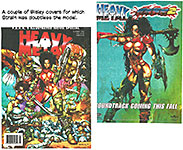
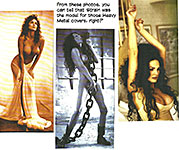

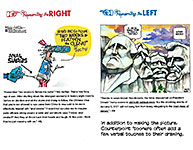
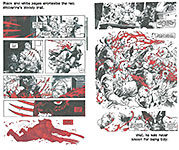
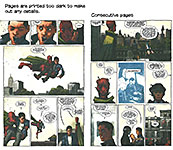
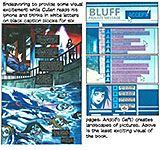
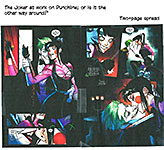
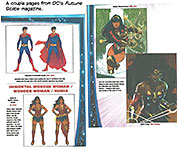

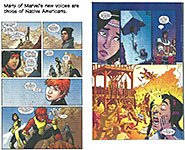

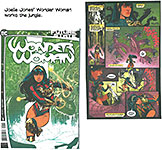
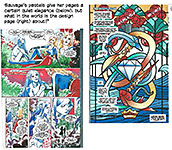
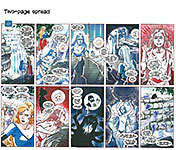
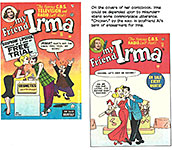
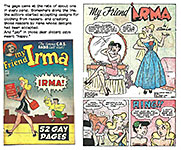
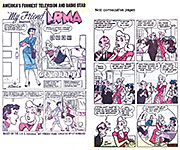
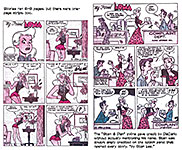
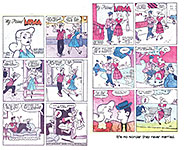
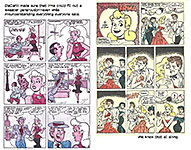
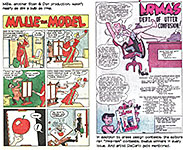
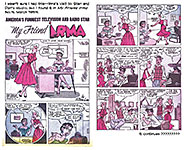
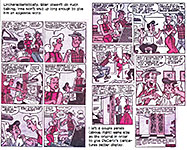
1.jpg)
2.jpg)
3.jpg)
4.jpg)
5.jpg)
6.jpg)
7.jpg)
8.jpg)
1.jpg)
2.jpg)
3.jpg)
4.jpg)
5.jpg)
6.jpg)
7.jpg)
8.jpg)
9.jpg)
10.jpg)
11.jpg)
12.jpg)
13.jpg)
14.jpg)
15.jpg)
1.jpg)
2.jpg)
3.jpg)
4.jpg)
5.jpg)
6.jpg)
7.jpg)
